Abstract
A series of twenty-two quinazolinamine derivatives showing potent inhibitory activities on breast cancer resistance protein (BCRP) and p-glycoprotein (P-gp) were synthesized. A cyclopropyl-containing quinazolinamine 22 was identified as a dual BCRP and P-gp inhibitor, while azide-containing quinazolinamine 33 showed BCRP inhibitory activity. These lead compounds were further investigated in a battery of mechanistic experiments. Compound 22 changed the localization of BCRP and P-gp in cells, thus inhibiting the efflux of anticancer drugs by the two ATP-binding cassette (ABC) transporters. In addition, both 22 and 33 significantly stimulated the ATP hydrolysis of the BCRP transporter, indicating that they can be competitive substrates of the BCRP transporter, and thereby increase the accumulation of mitoxantrone in BCRP-overexpressing H460/MX20 cells. Azide derivative 33, exhibited a greater inhibitory effect on BCRP after UV activation and can serve as a valuable probe for investigating the interactions of quinazolinamine derivatives with BCRP. Notably, the dual BCRP and P-gp inhibitors 4–5, 22–24, 27, and BCRP inhibitor 33 showed improved metabolic stability compared to Ko143.
1. Introduction
The overexpression of ATP-binding cassette (ABC) transporters is an important cause of multi-drug resistance (MDR) in cancers. ABC transporters with seven subfamilies (ABCA–ABCG) are a superfamily of 48 transporters expressed in humans [1]. Breast cancer resistance protein (BCRP), the second member of the G subfamily of the ABC transporters, also named ABCG2, was identified in an MDR human breast cancer cell line MCF-7/AdrVp in 1998 [2]. Since then, it has been found to be mainly overexpressed in drug-resistant tumors. BCRP is an approximately 75 kDa polytopic plasma membrane protein with one cytoplasmic nucleotide binding domain and one transmembrane domain fused to a single polypeptide chain. BCRP is a half-transporter that dimerizes to become a functional homodimer with a molecular weight of approximately 144 kDa. P-gp, also named ABCB1, is a 141 kDa transporter that contains two transmembrane domains and two cytoplasmic nucleotide binding domains. P-gp is the first human ABC transporter identified through its ability to confer MDR in cancer cells.
The pharmacokinetic behaviors, efficacy, and toxicity of various anticancer drugs are dramatically altered by BCRP and P-gp. Cancers with overexpression of multiple transporters have been reported to be more resistant to chemotherapy than those with a single transporter expression, with worse prognosis. BCRP and P-gp are co-expressed in certain cancers, such as leukemia.
Fumitremorgin C (FTC) (Figure 1) is the first reported BCRP inhibitor [3] with severe neurotoxicity in vivo. The FTC analogue Ko143 (Figure 1) was discovered to be a potent BCRP inhibitor with low toxicity [4]. It was reported that Ko143 is not only a BCRP inhibitor but also a weak P-gp inhibitor [5]. Nevertheless, clinical use of Ko143 is hindered due to its rapid metabolism to inactive metabolites in rats [5].

Figure 1.
Structure of FTC and Ko143.
Gefitinib (Figure 2), an epidermal growth factor receptor (EGFR) inhibitor with quinazolinamine moiety, was reported to inhibit BCRP [6] but also modulate the function of P-gp in multidrug-resistant cancer cells [7]. Inspired by previous reports that gefitinib is a BCRP inhibitor [6], Wiese et al. synthesized a series of quinazolinamines (Figure 2) derived from gefitinib as BCRP inhibitors. In addition, the results showed that some quinazolinamines exhibit P-gp inhibitory activities [8,9]. Quinazolinamine derivatives, which share structural similarity with the BCRP and P-gp dual inhibitor gefitinib, have the potential to inhibit both BCRP and P-gp activities. Further investigation of the structure–activity relationship (SAR) of the quinazolinamine derivatives can help discover potent BCRP and P-gp dual inhibitors with enhanced pharmacokinetic properties. The mechanisms of action of quinazolinamine derivatives reversing MDR in cancers were also investigated.
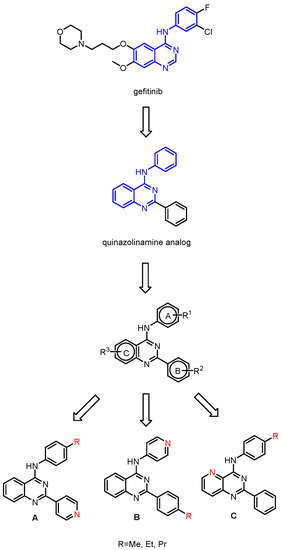
Figure 2.
Structure of gefitinib and quinazolinamine derivatives.
Nitrogen as a hydrogen bond acceptor can play an important role in the interaction of the quinazolinamine derivatives with ABC transporters. Therefore, a nitrogen atom was incorporated, and its position in the aromatic rings varied to investigate the importance of the nitrogen atom and its location. Target compounds with scaffolds A, B, and C (Figure 2) were designed, which contain a nitrogen atom in rings A, B, or C, respectively. The reports showed that quinazolinamine derivatives with the substitutions at para or meta position are more potent than those with the substitutions at ortho position [9]. Both BCRP and P-gp are known to transport hydrophobic compounds [10], suggesting that hydrophobicity plays an important role in the binding affinity of target compounds for these transporters. Thus, methyl, ethyl and n-propyl groups were introduced on rings A or B at para position, in scaffolds A (3–5), B (12–14), and C (18–20) to evaluate the role of hydrophobicity on the binding affinity of the target compounds to BCRP and P-gp transporters.
2. Materials and Methods
2.1. Synthesis of Quinazolinamines
1H NMR and 13C NMR spectra were acquired with a Bruker 400 UltrashieldTM spectrophotometer (400 MHz). Infrared spectra (IR) were acquired with PerkinElmer Spectrum 100 FT-IR Spectrometers with the exclusive universal ATR accessory. High resolution mass spectra (HRMS) were obtained for all target compounds on a Waters Xevo G2-XS QToF mass spectrometer equipped with H-Class UPLC inlet and a LockSpray electrospray ionization (ESI) source. Reactions were monitored by thin layer chromatography (TLC) and visualized using UV light at 254 nm. TLC was performed using Analtech UniplateTM Silica Gel GF 250 Micron plates. The purification of the reaction mixtures was conducted using silica gel column chromatography or Reveleris® X2 flash chromatography system by BÜCHI Labortechnik AG. Melting points were determined on a Thomas-Hoover Capillary Melting Point Apparatus. The purity of all target compounds was determined by high-performance liquid chromatography (HPLC), (LC, Agilent 1200 Infinity; column, Agilent HC-C18(2), 170 Å, 4.6 × 250 mm, 5 µm; column temperature, 25 °C; mobile phase, solvent A, methanol, solvent B, water, gradient elution, 30–99% solvent A; flow rate, 1 mL/min; UV signals were recorded at 254 nm). All tested compounds were shown to have >95% purity according to HPLC. Chemicals were purchased from Acros Organics or Alfa Aesar Chemical Company and used without further purification.
2-(Pyridin-4-yl)quinazolin-4(3H)-one (1). A mixture of anthranilamide (681 mg, 5 mmol), 4-pyridinecarboxaldehyde (536 mg, 5 mmol), iodine (1.40 g, 5.5 mmol), and anhydrous potassium carbonate (690 mg, 5 mmol) in 10 mL of dimethylformamide (DMF) was stirred at reflux for 4 h. Completion of the reaction was monitored by TLC and the mixture was poured into crushed ice to obtain a precipitate. The pH of the mixture was adjusted to 7.0 with concentrated HCl to optimize the precipitation of the desired product. After filtering off the precipitate, it was thoroughly washed with a 20% sodium thiosulfate solution (50 mL) followed by 50 mL of hot distilled water (50 mL). Purification was performed by recrystallization from ethanol to yield 1 as a white solid in 65% yield. 1H NMR (400 MHz, DMSO) δ 12.83 (s, 1H), 8.80 (dd, J = 4.6, 1.5 Hz, 2H), 8.19 (dd, J = 7.9, 1.1 Hz, 1H), 8.14–8.09 (m, 2H), 7.93–7.85 (m, 1H), 7.80 (d, J = 7.8 Hz, 1H), 7.63–7.55 (m, 1H).
4-Chloro-2-(pyridin-4-yl)quinazolinamine (2). Compound 1 (446 mg, 2 mmol) was added to the DMF (5 mL) containing phosphorus oxychloride (0.47 mL, 5 mmol) and stirred for 10 min at room temperature. The mixture was then refluxed for 2 h and the reaction monitored by TLC. After the completion of the reaction, excess phosphorus oxychloride was removed under reduced pressure and the residue was poured into ice water (20 mL). Subsequently, the pH of the mixture was adjusted slowly to 7.0 with 25% NaOH solution and extracted three times with dichloromethane (3 × 20 mL). The organic phase was collected, washed with brine (50 mL) and dried over magnesium sulfate. The solvent was removed under reduced pressure to obtain Compound 2 as a white solid, which was recrystallized from isopropanol in 96% yield. 1H NMR (400 MHz, DMSO) δ 8.84 (dd, J = 4.6, 1.5 Hz, 2H), 8.37 (dd, J = 4.5, 1.6 Hz, 3H), 8.28–8.16 (m, 2H), 7.95 (ddd, J = 8.2, 6.5, 1.6 Hz, 1H).
2.1.1. General Procedure for the Preparation of the Substituted 4-Anilinoquinazolinamines 3–5
4-Chloroquinazolinamine derivative 2 was added to a solution of a para substituted aniline derivative in isopropanol and the mixture was refluxed for a period of 2 h until the completion of the reaction as indicated by TLC. The precipitate that was formed was filtered off, washed with isopropanol (10 mL) and recrystallized from ethanol.
2-(Pyridin-4-yl)-N-(p-tolyl)quinazolin-4-amine (3). Compound 3 was synthesized from Compound 2 (42 mg, 0.17 mmol) reacted with para-methyl aniline (21 mg, 0.20 mmol) as described in the general procedure. It was obtained as a yellow solid (30 mg) in 56% yield, mp. 269–270 °C; IR: 3058, 1562, 1500, 1422, 815, 786 cm−1; 1H NMR (400 MHz, DMSO) δ 10.36 (s, 1H), 9.00 (dd, J = 5.3, 1.3 Hz, 2H), 8.72 (d, J = 8.3 Hz, 1H), 8.66 (d, J = 6.5 Hz, 2H), 8.04–7.95 (m, 2H), 7.82–7.71 (m, 3H), 7.31 (d, J = 8.2 Hz, 2H), 2.37 (s, 3H). 13C NMR (101 MHz, DMSO) δ 158.79, 155.65, 151.17, 149.24, 145.06, 136.26, 134.50, 134.15, 129.52, 128.34, 128.17, 124.34, 123.89, 123.39, 114.84, 21.09. HRMS (ESI) m/z calcd for [C20H16N4 + H]+ 313.1453, found 313.1463.
N-(4-Ethylphenyl)-2-(pyridin-4-yl)quinazolin-4-amine (4). Compound 4 was synthesized from Compound 2 (48 mg, 0.20 mmol) reacted with para-ethyl aniline (26 mg, 0.21 mmol), as described in the general procedure. It was obtained as a yellow solid (50 mg) in 77% yield, mp. 228–230 °C; IR: 2969, 1589, 1614, 1366, 798, 776 cm−1; 1H NMR (400 MHz, DMSO) δ 9.96 (s, 1H), 8.76 (d, J = 5.8 Hz, 2H), 8.62 (d, J = 8.3 Hz, 1H), 8.28 (dd, J = 4.5, 1.5 Hz, 2H), 7.92 (d, J = 3.8 Hz, 2H), 7.87 (d, J = 8.5 Hz, 2H), 7.72–7.65 (m, 1H), 7.33 (d, J = 8.5 Hz, 2H), 2.67 (q, J = 7.6 Hz, 2H), 1.25 (t, J = 7.6 Hz, 3H). 13C NMR (101 MHz, DMSO) δ 158.63, 157.11, 150.15, 148.96, 148.85, 147.75, 140.12, 136.85, 134.12, 128.59, 128.27, 127.65, 123.59, 123.01, 114.85, 28.15, 16.09. HRMS (ESI) m/z calcd for [C21H18N4 + H]+ 327.1610, found 327.1611
N-(4-Propylphenyl)-2-(pyridin-4-yl)quinazolin-4-amine (5). Compound 5 was synthesized from Compound 2 (241 mg, 1 mmol) reacted with para-propyl aniline (135 mg, 1 mmol), as described in the general procedure as a yellow solid (241 mg) in 71% yield, mp. 212–214 °C; IR: 2931, 1513, 1366, 797, 766 cm−1; 1H NMR (400 MHz, DMSO) δ 9.96 (s, 1H), 8.75 (d, J = 5.9 Hz, 2H), 8.62 (d, J = 8.4 Hz, 1H), 8.28 (d, J = 5.9 Hz, 2H), 7.92 (d, J = 3.9 Hz, 2H), 7.87 (d, J = 8.4 Hz, 2H), 7.69 (dt, J = 8.4, 4.1 Hz, 1H), 7.31 (d, J = 8.4 Hz, 2H), 2.65–2.57 (m, 2H), 1.65 (dd, J = 15.0, 7.5 Hz, 2H), 0.95 (t, J = 7.3 Hz, 3H). 13C NMR (101 MHz, DMSO) δ 158.61, 157.77, 150.65, 150.53, 146.10, 138.35, 137.06, 133.97, 128.85, 128.76, 127.33, 123.52, 122.84, 122.28, 114.87, 37.22, 24.58, 14.13. HRMS (ESI) m/z calcd for [C22H20N4 + H]+ 341.1766, found 341.1780.
2.1.2. General Procedure for the Preparation of the Quinazolinamine Derivatives 6–8
A mixture of anthranilamide (1.36 g, 10 mmol), the corresponding aldehyde (10 mmol) and iodine (6.3 g, 25 mmol) in ethanol (20 mL) was refluxed for 6 h. During the reaction, air was pushed into the mixture. Completion of the reaction was monitored by TLC and the mixture was poured into 20% sodium thiosulfate (50 mL) solution followed by hot distilled water (50 mL). Purification was performed by recrystallization from ethanol.
2-(p-Tolyl)quinazolin-4(3H)-one (6). Compound 6 [11] was synthesized as described in the general procedure. A mixture of anthranilamide (681 mg, 5 mmol), the para-methyl aldehyde (661 mg, 5.5 mmol), iodine (1.397 g, 5.5 mmol) in ethanol (20 mL) was refluxed for 5 h. Compound 6 was obtained as a white solid (980 mg) in 83% yield. 1H NMR (400 MHz, DMSO) δ 12.49 (s, 1H), 8.15 (d, J = 7.9 Hz, 1H), 8.11 (d, J = 8.2 Hz, 2H), 7.83 (d, J = 7.0 Hz, 1H), 7.74 (d, J = 8.1 Hz, 1H), 7.52 (t, J = 7.6 Hz, 1H), 7.37 (d, J = 8.4 Hz, 2H), 2.40 (s, 3H).
2-(4-Ethylphenyl)quinazolin-4(3H)-one (7). Compound 7 [11] was synthesized as described in the general procedure. A mixture of anthranilamide (680 mg, 5 mmol), the para-ethyl aldehyde (670 mg, 5 mmol), and iodine (1.397 g, 5.5 mmol) in ethanol (30 mL) was refluxed for 7 h. Compound 7 was obtained as a white solid (1.288 g) in 84% yield. 1H NMR (400 MHz, DMSO) δ 12.50 (s, 1H), 8.15 (dd, J = 14.0, 4.8 Hz, 3H), 7.87–7.81 (m, 1H), 7.74 (d, J = 8.1 Hz, 1H), 7.55–7.48 (m, 1H), 7.40 (d, J = 8.2 Hz, 2H), 2.70 (q, J = 7.6 Hz, 2H), 1.23 (t, J = 7.6 Hz, 3H).
2-(4-Propylphenyl)quinazolin-4(3H)-one (8). Compound 8 [12] was synthesized as described in the general procedure. A mixture of anthranilamide (680 mg, 5 mmol), the para-propyl aldehyde (740 mg, 5 mmol), and iodine (1.397 g, 5.5 mmol) in ethanol (30 mL) was refluxed for 7 h. Compound 8 was obtained as a white solid in 98% yield. 1H NMR (400 MHz, DMSO) δ 12.49 (s, 1H), 8.18–8.09 (m, 3H), 7.84 (ddd, J = 8.6, 7.1, 1.6 Hz, 1H), 7.73 (dd, J = 8.2, 0.6 Hz, 1H), 7.55–7.49 (m, 1H), 7.38 (d, J = 8.4 Hz, 2H), 2.69–2.62 (m, 2H), 1.72–1.57 (m, 2H), 0.92 (dd, J = 8.5, 6.2 Hz, 3H).
2.1.3. General Procedure for the Preparation of the 4-Chloro-quinazolinamine Derivatives 9–11
Quinazolinamine derivative 6–8 (2 mmol) was added to the DMF (5 mL) containing phosphorus oxychloride (0.47 mL, 5 mmol) and stirred for 10 min at room temperature. The mixture was then refluxed for 2 h and the reaction monitored by TLC. After completion of the reaction, excess phosphorus oxychloride was removed under reduced pressure and the residue was poured into ice water (20 mL). Subsequently, the pH of the mixture was adjusted slowly to 7.0 with 25% NaOH solution and was extracted three times with dichloromethane (3 × 20 mL). With a separatory funnel, the organic phase was collected, washed with 50 mL brine and dried over magnesium sulfate. The solvent was removed under reduced pressure to obtain a white solid, which was recrystallized from isopropanol.
4-Chloro-2-(p-tolyl)quinazolinamine (9). Compound 9 was synthesized from Compound 6 as described in the general procedure. Compound 6 (590 mg, 2.5 mmol) reacted with phosphorus oxychloride (5 mL) to obtain a white solid (540 mg) in 85% yield. 1H NMR (400 MHz, DMO) δ 8.17 (dd, J = 7.9, 1.3 Hz, 1H), 8.09 (d, J = 8.3 Hz, 2H), 7.87 (ddd, J = 8.5, 7.1, 1.5 Hz, 1H), 7.79 (d, J = 7.7 Hz, 1H), 7.59–7.52 (m, 1H), 7.39 (d, J = 8.0 Hz, 2H), 2.41 (s, 3H).
4-Chloro-2-(4-ethylphenyl)quinazolinamine (10). Compound 10 was synthesized with Compound 7, as described in the general procedure. Compound 7 (500 mg, 2.0 mmol) reacted with phosphorus oxychloride (2 mL) to obtain a white solid (520 mg) in 97% yield. 1H NMR (400 MHz, DMSO) δ 8.18 (dd, J = 7.9, 1.4 Hz, 1H), 8.14–8.08 (m, 2H), 7.92–7.83 (m, 2H), 7.58 (ddd, J = 8.1, 6.7, 1.6 Hz, 1H), 7.44 (d, J = 8.5 Hz, 2H), 2.72 (q, J = 7.6 Hz, 2H), 1.24 (t, J = 7.6 Hz, 3H).
4-Chloro-2-(4-propylphenyl)quinazolinamine (11). Compound 11 was synthesized with Compound 8 as described in the general procedure. Compound 8 (792 mg, 3.0 mmol) reacted with phosphorus oxychloride (6 mL) to obtain a white solid (770 mg) in 91% yield. 1H NMR (400 MHz, DMSO) δ 8.42 (d, J = 8.3 Hz, 2H), 8.31–8.27 (m, 1H), 8.16–8.09 (m, 2H), 7.84 (ddd, J = 8.2, 4.8, 3.3 Hz, 1H), 7.42 (d, J = 8.4 Hz, 2H), 2.71–2.63 (m, 2H), 1.73–1.60 (m, 2H), 0.94 (t, J = 7.3 Hz, 3H).
2.1.4. General Procedure for the Preparation of the Substituted 4-Anilinoquinazolinamines 12–14
4-Chloroquinazolinamine derivative 9–11 (1 equivalent), p-aminopyridine (94 mg, 1.1 equivalent) and triethylamine (1.1 equivalent) were taken into isopropanol (5 mL). The mixture was refluxed for a period of 3 h until the completion of the reaction as indicated by TLC. The solvent was removed under reduced pressure and the remaining solid was purified using flash column chromatography.
N-(Pyridin-4-yl)-2-(p-tolyl)quinazolin-4-amine (12). Compound 12 was synthesized as described in the general procedure. Compound 9 (25 mg, 0.1 mmol) was added to a solution of p-aminopyridine (10 mg, 0.11 mmol) and triethylamine (11 mg, 0.11 mmol) to obtain a white solid (17 mg) in 53% yield, mp. 278–279 °C; IR: 2997, 1642, 1542, 1370, 1321, 1160, 732 cm−1; 1H NMR (400 MHz, DMSO) δ 9.03 (s, 1H), 8.76 (d, J = 7.2 Hz, 2H), 8.47 (d, J = 8.2 Hz, 2H), 8.27 (d, J = 8.0 Hz, 1H), 8.19 (t, J = 7.0 Hz, 1H), 8.01 (d, J = 8.2 Hz, 1H), 7.84 (t, J = 7.1 Hz, 1H), 7.43 (d, J = 8.1 Hz, 2H), 7.13 (d, J = 7.1 Hz, 2H), 2.43 (s, 3H). 13C NMR (101 MHz, DMSO) δ 160.97, 159.50, 159.47, 153.81, 142.80, 142.24, 136.53, 133.79, 130.09, 129.71, 129.11, 128.75, 124.59, 116.78, 109.88, 21.56. HRMS (ESI) m/z calcd for [C20H16N4 + H]+ 313.1453, found 313.1455.
2-(4-Ethylphenyl)-N-(pyridin-4-yl)quinazolin-4-amine (13). Compound 13 was synthesized as described in the general procedure. Compound 10 (134 mg, 0.5 mmol) was added to a solution of p-aminopyridine (55 mg, 0.55 mmol) and triethyl-amine (11 mg, 0.11 mmol) to obtain a yellow solid (106 mg) in 65% yield, mp. 234–236 °C; IR: 3294, 2967, 1569, 1503, 826, 755 cm−1; 1H NMR (400 MHz, DMSO) δ 10.11 (s, 1H), 8.59 (dd, J = 14.2, 7.3 Hz, 3H), 8.41 (d, J = 8.3 Hz, 2H), 8.10 (dd, J = 4.9, 1.5 Hz, 2H), 7.93 (d, J = 3.8 Hz, 2H), 7.67 (dt, J = 8.3, 4.1 Hz, 1H), 7.41 (d, J = 8.3 Hz, 2H), 2.71 (q, J = 7.6 Hz, 2H), 1.25 (t, J = 7.6 Hz, 4H). 13C NMR (101 MHz, DMSO) δ 159.44, 158.27, 151.17, 150.52, 147.03, 146.98, 136.00, 134.19, 128.68, 128.53, 126.75, 123.55, 115.55, 114.53, 28.55, 15.84. HRMS (ESI) m/z calcd for [C21H18N4 + H]+ 327.1610, found 327.1619.
2-(4-Propylphenyl)-N-(pyridin-4-yl)quinazolin-4-amine (14). Compound 14 was synthesized as described in the general procedure. Compound 11 (177 mg, 0.63 mmol) was added to a solution of p-aminopyridine (65 mg, 0.66 mmol) and triethylamine (66 mg, 0.66 mmol) to obtain a yellow solid (134 mg) in 63% yield, mp. 218–220 °C; IR: 2962, 1569, 1504, 822, 754 cm−1; 1H NMR (400 MHz, DMSO) δ 10.12 (s, 1H), 8.60 (dd, J = 14.2, 7.3 Hz, 3H), 8.41 (d, J = 8.1 Hz, 2H), 8.10 (d, J = 6.3 Hz, 2H), 7.93 (d, J = 4.3 Hz, 2H), 7.68 (dt, J = 8.2, 4.2 Hz, 1H), 7.39 (d, J = 8.0 Hz, 2H), 2.70–2.61 (m, 2H), 1.72–1.59 (m, 2H), 0.94 (t, J = 7.3 Hz, 3H). 13C NMR (101 MHz, DMSO) δ 159.45, 158.28, 151.18, 150.53, 146.98, 145.42, 136.03, 134.20, 129.12, 128.68, 128.45, 126.75, 123.56, 115.55, 114.53, 37.58, 24.35, 14.11. HRMS (ESI) m/z calcd for [C22H20N4 + H]+ 341.1766, found 341.1773.
2.1.5. Preparation of Compounds 15–17
Methyl 3-benzamidopicolinate (15) [13]. To a mixture of methyl 3-aminopicolinate (2.09 g, 5 mmol) and triethylamine (0.7 mL, 5 mmol) in chloroform (10 mL), benzoyl chloride (428 mg, 5.5 mmol) was added dropwise at 5 °C. After stirring at room temperature for 2.5 h, the reaction mixture was diluted with chloroform and washed with saturated sodium bicarbonate (30 mL) and brine (30 mL). The organic layer was dried over sodium sulfate and concentrated in vacuo. The resulting solid was recrystallized from ethyl acetate to obtain Compound 15 as a white solid in 86% yield. 1H NMR (400 MHz, DMSO) δ 11.32 (s, 1H), 8.74 (dd, J = 8.5, 1.5 Hz, 1H), 8.46 (dd, J = 4.5, 1.5 Hz, 1H), 8.01–7.95 (m, 2H), 7.75–7.57 (m, 4H), 3.89 (s, 3H).
2-Phenylpyrido[3,2-d]pyrimidin-4(3H)-one (16) [14]. To a solution of 15 (256 mg, 1 mmol) in methanol (20 mL) was added 28% aqueous ammonia (20 mL). After stirring at room temperature for 2 h, the reaction mixture was filtered to obtain a mixture of uncyclized benzamide. Isopropanol (5 mL) and 2 N sodium hydroxide (2 mL) were added and the crude mixture was heated at reflux for 3 h. The mixture was cooled, neutralized with 2 N HCl, and the solution was evaporated to obtain a precipitate, which was collected to obtain 23 as a white solid in 60% yield. 1H NMR (400 MHz, DMSO) δ 12.83 (s, 1H), 8.79 (dd, J = 4.3, 1.5 Hz, 1H), 8.23–8.13 (m, 3H), 7.84 (dd, J = 8.3, 4.3 Hz, 1H), 7.66–7.54 (m, 3H).
4-Chloro-2-phenylpyrido[3,2-d]pyrimidine (17). Compound 16 (2 mmol) was added to DMF (5 mL) containing phosphorus oxychloride (0.47 mL, 5 mmol) and stirred for 10 min at room temperature. The mixture was then refluxed for 2 h and the reaction was monitored by TLC. After completion of the reaction, excess phosphorus oxychloride was removed under reduced pressure and the residue was poured into ice water (20 mL). Subsequently, the pH of the mixture was adjusted slowly to 7.0 with 25% NaOH solution and was extracted three times with dichloromethane (3 × 20 mL). The organic phase was collected, washed with brine (50 mL) and dried over magnesium sulfate. The solvent was removed under reduced pressure to obtain a white solid, which was recrystallized from isopropanol in 94% yield. 1H NMR (400 MHz, DMSO) δ 9.17 (dd, J = 4.1, 1.5 Hz, 1H), 8.60–8.47 (m, 3H), 8.13 (dd, J = 8.6, 4.1 Hz, 1H), 7.67–7.57 (m, 3H).
2.1.6. General Procedure for the Preparation of the Substituted 4-Anilinoquinazolinamines 18–29
4-Chloroquinazolinamine derivative 2 (1 equivalent) or 17 (1 equivalent) was added to a solution of a para-substituted aniline derivative (1.1 equivalent) and triethylamine (1.1 equivalent) in isopropanol (3 mL) to synthesize 18–20, 22–25, 27–29. In the case of compounds 21 and 26, 4-dimethylaminopyridine was used in place of triethylamine. The mixture was refluxed for a period of 3 h until completion of the reaction as indicated by TLC. The solvent was removed under reduced pressure and the remaining solid was purified with flash column.
2-Phenyl-N-(p-tolyl)pyrido[3,2-d]pyrimidin-4-amine (18). Compound 18 was synthesized as described in the general procedure. Compound 17 (90 mg, 0.37 mmol) was added to a solution of 4-methylaniline (53 mg, 0.5 mmol) and triethylamine (55.6 mg, 0.55 mmol) to obtain a yellow solid (84 mg) in 73% yield, mp. 161–162 °C; IR: 3333, 1597, 1563, 1409, 802 cm−1; 1H NMR (400 MHz, DMSO) δ 10.11 (s, 1H), 8.59 (dd, J = 14.2, 7.3 Hz, 3H), 8.41 (d, J = 8.3 Hz, 2H), 8.10 (dd, J = 4.9, 1.5 Hz, 2H), 7.93 (d, J = 3.8 Hz, 2H), 7.67 (dt, J = 8.3, 4.1 Hz, 1H), 7.41 (d, J = 8.3 Hz, 2H), 2.71 (q, J = 7.6 Hz, 2H), 1.25 (t, J = 7.6 Hz, 4H). 13C NMR (101 MHz, DMSO) δ 160.29, 157.77, 149.06, 145.60, 138.40, 136.72, 136.41, 133.21, 131.19, 131.12, 129.49, 129.13, 129.00, 128.60, 122.02, 21.03. HRMS (ESI) m/z calcd for [C20H16N4 + H]+ 313.1453, found 313.1465.
N-(4-Ethylphenyl)-2-phenylpyrido[3,2-d]pyrimidin-4-amine (19). Compound 19 was synthesized as described in the general procedure. Compound 17 (90 mg, 0.37 mmol) was added to a solution of 4-ethylaniline (60 mg, 0.5 mmol) and triethylamine (50 mg, 0.5 mmol) to obtain as a yellow solid (121 mg) in 75% yield, mp. 137–138 °C; IR: 3330, 2962, 1595, 1564, 823, 707 cm−1; 1H NMR (400 MHz, DMSO) δ 10.28 (s, 1H), 8.91 (dd, J = 4.2, 1.5 Hz, 1H), 8.55–8.45 (m, 2H), 8.28 (dd, J = 8.5, 1.5 Hz, 1H), 8.07 (d, J = 8.5 Hz, 2H), 7.93 (dd, J = 8.5, 4.2 Hz, 1H), 7.61–7.51 (m, 3H), 7.32 (d, J = 8.5 Hz, 2H), 2.65 (q, J = 7.5 Hz, 2H), 1.23 (t, J = 7.6 Hz, 3H). 13C NMR (101 MHz, DMSO) δ 160.35, 157.72, 149.11, 145.53, 139.69, 138.36, 136.87, 136.36, 131.15, 131.11, 129.14, 129.01, 128.60, 128.33, 121.92, 28.14, 16.16. HRMS (ESI) m/z calcd for [C21H18N4 + H]+ 327.1610, found 327.1620.
2-Phenyl-N-(4-propylphenyl)pyrido[3,2-d]pyrimidin-4-amine (20). Compound 20 was synthesized as described in the general procedure. Compound 17 (77 mg, 0.32 mmol) was added to a solution of 4-propylaniline (47 mg, 0.35 mmol) and triethylamine (39 mg, 0.39 mmol) to obtain a yellow solid (74 mg) in 68% yield, mp. 117–119 °C; IR:3342, 2929, 1594, 1565, 803, 707 cm−1; 1H NMR (400 MHz, DMSO) δ 10.28 (s, 1H), 8.91 (dd, J = 4.2, 1.5 Hz, 1H), 8.49 (dd, J = 6.6, 3.2 Hz, 2H), 8.29 (dd, J = 8.5, 1.5 Hz, 1H), 8.07 (d, J = 8.5 Hz, 2H), 7.93 (dd, J = 8.5, 4.2 Hz, 1H), 7.56 (dd, J = 5.2, 1.8 Hz, 3H), 7.30 (d, J = 8.5 Hz, 2H), 2.64–2.56 (m, 2H), 1.70–1.58 (m, 2H), 0.94 (t, J = 7.3 Hz, 3H). 13C NMR (101 MHz, DMSO) δ 160.33, 157.69, 149.06, 145.53, 138.37, 138.00, 136.93, 136.36, 131.12, 129.10, 128.99, 128.89, 128.61, 121.80, 37.22, 24.60, 14.13. HRMS (ESI) m/z calcd for [C22H20N4 + H]+ 341.1766, found 341.1775.
N-Phenyl-2-(pyridin-4-yl)quinazolin-4-amine (21). Compound 21 was synthesized, as described in the general procedure. Compound 2 (24 mg, 0.1 mmol) was added to a solution of phenylamine (10 mg, 0.11 mmol) and 4-dimethylaminopyridine (13 mg, 0.11 mmol) to yield a white solid (25 mg) in 85% yield, mp. 282–284 °C; IR:3261, 3043, 1554, 1523, 1411, 745 cm−1; 1H NMR (400 MHz, DMSO) δ 10.02 (s, 1H), 8.75 (d, J = 6.0 Hz, 2H), 8.63 (d, J = 8.4 Hz, 1H), 8.28 (d, J = 6.0 Hz, 2H), 7.95 (dd, J = 9.9, 5.9 Hz, 4H), 7.74–7.66 (m, 1H), 7.50 (t, J = 7.9 Hz, 2H), 7.21 (t, J = 7.4 Hz, 1H). 13C NMR (101 MHz, DMSO) δ 158.67, 157.73, 150.72, 150.62, 145.99, 139.44, 134.01, 129.05, 128.82, 127.35, 124.48, 123.62, 122.98, 122.23, 114.91. HRMS (ESI) m/z calcd for [C19H14N4 + H]+ 299.1297, found 299.1303.
N-(4-Cyclopropylphenyl)-2-(pyridin-4-yl)quinazolin-4-amine (22). Compound 22 was synthesized as described in the general procedure. Compound 2 (50 mg, 0.21 mmol) was added to a solution of 4-cyclopropylaniline (42 mg, 0.25 mmol) and triethylamine (25 mg, 0.25 mmol) to obtain a yellow solid (35 mg) in 50% yield, mp. 231–232 °C; IR: 3003, 1515, 1409, 1363, 765 cm−1; 1H NMR (400 MHz, DMSO) δ 9.93 (s, 1H), 8.75 (d, J = 5.8 Hz, 2H), 8.60 (d, J = 8.4 Hz, 1H), 8.34–8.21 (m, 2H), 7.91 (d, J = 3.7 Hz, 2H), 7.83 (d, J = 8.5 Hz, 2H), 7.74–7.61 (m, 1H), 7.20 (d, J = 8.5 Hz, 2H), 2.03–1.92 (m, 1H), 1.03–0.92 (m, 2H), 0.79–0.67 (m, 2H). 13C NMR (101 MHz, DMSO) δ 158.56, 157.79, 150.72, 150.58, 146.05, 139.78, 136.80, 133.90, 128.79, 127.24, 125.89, 123.58, 122.89, 122.23, 114.92, 15.26, 9.74. HRMS (ESI) m/z calcd for [C22H18N4 + H]+ 339.1610, found 339.1617.
N-(4-Isopropylphenyl)-2-(pyridin-4-yl)quinazolin-4-amine (23). Compound 23 was synthesized as described in the general procedure. Compound 2 (48 mg, 0.2 mmol) was added to a solution of 4-isopropylaniline (30 mg, 0.22 mmol) and triethylamine (22 mg, 0.22 mmol) to obtain a yellow solid (52 mg) in 76% yield, mp. 225–226 °C; IR: 2958, 1563, 1513, 1415, 764 cm−1; 1H NMR (400 MHz, DMSO) δ 9.95 (s, 1H), 8.84–8.70 (m, 2H), 8.63 (d, J = 8.3 Hz, 1H), 8.37–8.20 (m, 2H), 7.91 (t, J = 5.7 Hz, 4H), 7.69 (dt, J = 8.3, 4.2 Hz, 1H), 7.36 (d, J = 8.5 Hz, 2H), 2.95 (dt, J = 13.5, 6.7 Hz, 1H), 1.27 (s, 3H), 1.26 (s, 3H). 13C NMR (101 MHz, DMSO) δ 158.55, 157.81, 150.73, 150.57, 146.05, 144.48, 137.24, 133.91, 128.81, 127.25, 126.77, 123.60, 122.68, 122.24, 114.92, 33.46, 24.49. HRMS (ESI) m/z calcd for [C22H20N4 + H]+ 341.1766, found 341.1780.
N-(3-Ethylphenyl)-2-(pyridin-4-yl)quinazolin-4-amine (24). Compound 24 was synthesized as described in the general procedure. Compound 2 (84 mg, 0.35 mmol) was added to a solution of 3-ethylaniline (48 mg, 0.40 mmol) and triethylamine (40 mg, 0.40 mmol) to obtain a yellow solid (89 mg) in 78% yield, mp. 236–238 °C; IR: 2963, 2440, 1568, 1378, 767 cm−1; 1H NMR (400 MHz, DMSO) δ 10.20 (s, 1H), 8.94 (d, J = 4.8 Hz, 2H), 8.68 (d, J = 8.1 Hz, 1H), 8.58 (s, 2H), 7.99 (s, 2H), 7.81–7.69 (m, 3H), 7.40 (t, J = 7.9 Hz, 1H), 7.09 (d, J = 8.0 Hz, 1H), 2.71 (q, J = 7.4 Hz, 2H), 1.28 (t, J = 7.6 Hz, 3H). 13C NMR (101 MHz, DMSO) δ 158.95, 155.71, 145.11, 144.67, 138.93, 134.57, 128.99, 128.41, 124.62, 124.36, 124.00, 122.84, 120.86, 114.99, 40.63, 40.42, 40.21, 40.00, 39.80, 39.59, 39.38, 28.77, 16.10. HRMS (ESI) m/z calcd for [C21H18N4 + H]+ 327.1610, found 327.1620.
N-(3-Propylphenyl)-2-(pyridin-4-yl)quinazolin-4-amine (25). Compound 25 was synthesized as described in the general procedure. Compound 2 (31 mg, 0.13 mmol) was added to a solution of 3-propylaniline (21 mg, 0.16 mmol) and triethylamine (39 mg, 0.39 mmol) to obtain a yellow solid (32 mg) in 72% yield, mp. 205–207 °C; IR: 2955, 1524, 1365, 787, 757 cm−1; 1H NMR (400 MHz, DMSO) δ 9.97 (s, 1H), 8.74 (d, J = 6.0 Hz, 2H), 8.63 (d, J = 8.3 Hz, 1H), 8.29 (d, J = 6.0 Hz, 2H), 7.92 (d, J = 3.6 Hz, 2H), 7.84 (s, 1H), 7.74 (d, J = 8.9 Hz, 1H), 7.72–7.65 (m, 1H), 7.39 (t, J = 7.8 Hz, 1H), 7.04 (d, J = 7.5 Hz, 1H), 2.68–2.61 (m, 2H), 1.70 (dt, J = 14.5, 7.2 Hz, 2H), 0.98 (t, J = 7.3 Hz, 3H). 13C NMR (101 MHz, DMSO) δ 158.65, 157.69, 150.65, 146.05, 142.90, 139.36, 133.97, 128.84, 127.32, 124.65, 123.62, 123.00, 122.23, 120.36, 114.94, 37.94, 24.65, 14.19. HRMS (ESI) m/z calcd for [C22H20N4 + H]+ 341.1766, found 341.1779.
2-Nitro-4-((2-(pyridin-4-yl)quinazolin-4-yl)amino)phenol (26). Compound 26 was synthesized as described in the general procedure. Compound 2 (24 mg, 0.1 mmol) was added to a solution of 4-amino-2-nitrophenol (17 mg, 0.11 mmol) and 4-dimethylaminopyridine (13 mg, 0.11 mmol) and triethylamine (39 mg, 0.39 mmol) to obtain a yellow solid (30 mg) in 83% yield, mp. 267–268 °C; IR: 3427, 3194, 1527, 1487, 1224, 769 cm−1; 1H NMR (400 MHz, DMSO) δ 8.83–8.69 (m, 2H), 8.43 (d, J = 8.3 Hz, 1H), 8.14 (s, 2H), 8.09–7.99 (m, 2H), 7.87 (s, 1H), 7.40 (d, J = 5.8 Hz, 2H), 7.06 (d, J = 8.9 Hz, 1H), 5.91 (s, 2H). 13C NMR (101 MHz, DMSO) δ 167.04, 157.17, 152.03, 150.95, 148.30, 144.29, 142.53, 135.93, 134.08, 129.37, 128.50, 126.09, 124.13, 121.88, 120.28, 115.02, 108.96. HRMS (ESI) m/z calcd for [C19H13N5O3 + H]+ 360.1097, found 360.1103.
N-(4-Methoxyphenyl)-2-(pyridin-4-yl)quinazolin-4-amine (27). Compound 27 was synthesized as described in the general procedure. Compound 2 (120 mg, 0.5 mmol) was added to a solution of 4-methoxyaniline (68 mg, 0.55 mmol) and triethylamine (55 mg, 0.55 mmol) to obtain a yellow solid (139 mg) in 85% yield. mp. 219–221 °C; IR: 3291, 1510, 1242, 823, 767 cm−1; 1H NMR (400 MHz, DMSO) δ 9.94 (s, 1H), 8.74 (d, J = 5.4 Hz, 2H), 8.58 (d, J = 8.3 Hz, 1H), 8.26 (d, J = 5.4 Hz, 2H), 7.90 (d, J = 3.8 Hz, 2H), 7.82 (d, J = 8.8 Hz, 2H), 7.67 (dt, J = 8.0, 4.1 Hz, 1H), 7.07 (d, J = 8.8 Hz, 2H), 3.79 (d, J = 22.1 Hz, 3H). 13C NMR (101 MHz, DMSO) δ 158.64, 157.78, 156.38, 150.64, 150.51, 146.08, 133.75, 132.30, 128.74, 127.10, 124.69, 123.51, 122.21, 114.85, 114.18, 55.72. HRMS (ESI) m/z calcd for [C20H16N4O + H]+ 329.1402, found 329.1411.
N1-(2-(Pyridin-4-yl)quinazolin-4-yl)benzene-1,4-diamine (28). Compound 28 was synthesized as described in the general procedure. Compound 2 (58 mg, 0.24 mmol) was added to a solution of 4-aminoaniline (30 mg, 0.28 mmol) and triethylamine (28 mg, 0.28 mmol) to obtain a pale white solid (66 mg) in 88% yield. mp. 301–303 °C; IR: 3445, 3363, 1556, 1512, 1411, 761 cm−1; 1H NMR (400 MHz, DMSO) δ 9.78 (s, 1H), 8.73 (d, J = 5.0 Hz, 2H), 8.54 (d, J = 8.3 Hz, 1H), 8.24 (d, J = 5.6 Hz, 2H), 7.86 (d, J = 3.8 Hz, 2H), 7.62 (dt, J = 8.1, 4.0 Hz, 1H), 7.49 (d, J = 8.6 Hz, 2H), 6.69 (d, J = 8.6 Hz, 2H), 5.34 (s, 2H). 13C NMR (101 MHz, DMSO) δ 158.72, 157.86, 150.57, 150.47, 146.28, 145.79, 133.59, 128.64, 128.13, 126.94, 124.98, 123.45, 122.20, 114.91, 114.34, 40.64, 40.43, 40.22, 40.01, 39.80, 39.59, 39.38. HRMS (ESI) m/z calcd for [C19H15N5 + H]+ 314.1406, found 314.1417.
N,2-Di(pyridin-4-yl)quinazolin-4-amine (29). Compound 29 was synthesized as described in the general procedure. Compound 2 (20 mg, 0. 08 mmol) was added to a solu-tion of p-aminopyridine (10 mg, 0.09 mmol) and triethylamine (9.1 mg, 0.09 mmol) to obtain a yellow solid (20 mg) in 80% yield. mp. 277–279 °C; IR: 2941, 1645, 1544, 1384, 1171, 776, 745 cm−1; 1H NMR (400 MHz, DMSO) δ 9.07 (s, 1H), 8.87 (d, J = 5.9 Hz, 2H), 8.77 (d, J = 7.4 Hz, 2H), 8.44 (d, J = 6.0 Hz, 2H), 8.36 (d, J = 8.4 Hz, 1H), 8.26 (t, J = 7.7 Hz, 1H), 8.10 (d, J = 8.3 Hz, 1H), 7.95 (t, J = 7.6 Hz, 1H), 7.15 (d, J = 7.5 Hz, 2H). 13C NMR (101 MHz, DMSO) δ 161.10, 159.91, 157.58, 153.59, 151.26, 143.73, 142.83, 136.86, 130.84, 129.49, 124.93, 122.36, 117.73, 109.92, 40.63, 40.42, 40.22, 40.01, 39.80, 39.59, 39.38. HRMS (ESI) m/z calcd for [C18H13N5 + H]+ 300.1249, found 300.1285.
2.1.7. Preparation of Compounds 30–33
N-(4-Isothiocyanatophenyl)-2-(pyridin-4-yl)quinazolin-4-amine (30). A solution of amine 28 (31 mg, 0.1 mmol) in dichloromethane (10 mL) was treated dropwise with a solution of di-2-pyridyl thionocarbonate (23 mg, 0.11 mmol) in dicholoromethane (1 mL) over a period of 1 min with vigorous stirring at room temperature. The precipitates were filtered and recrystallized from ethyl acetate to obtain a white solid in 73% yield, mp. 307–309 °C; IR: 3279, 3039, 2053, 1491, 1410, 749 cm−1; 1H NMR (400 MHz, DMSO) δ 10.15 (s, 1H), 8.77 (d, J = 5.0 Hz, 2H), 8.61 (d, J = 8.4 Hz, 1H), 8.29 (d, J = 4.9 Hz, 2H), 8.15–8.02 (m, 2H), 7.95 (d, J = 3.4 Hz, 2H), 7.79–7.67 (m, 1H), 7.57 (d, J = 8.6 Hz, 2H). 13C NMR (101 MHz, DMSO) δ 158.39, 157.61, 150.81, 150.71, 145.78, 139.21, 134.24, 133.50, 128.91, 127.56, 126.84, 125.29, 123.65, 123.56, 122.26, 114.94. HRMS (ESI) m/z calcd for [C20H13N5S + H]+ 356.0970, found 356.0985.
2-Bromo-N-(4-((2-(pyridin-4-yl)quinazolin-4-yl)amino)phenyl)acetamide (31). A solution of amine 28 (62 mg, 0.2 mmol) in dichloromethane (2 mL) was treated dropwise with a solution of bromoacetyl bromide (25 mg, 0.2 mmol) in dichloromethane (1 mL) over a period of 1 min with vigorous stirring at 0 °C. The reaction was stirred at room temperature for 24 h. Then, water (10 mL) was added into the mixture, and the precipitates were filtered and recrystallized from ethyl acetate to obtain a yellow solid in 72% yield, mp. 336–338 °C; IR: 3033, 1566, 1510, 763 cm−1; 1H NMR (400 MHz, DMSO) δ 10.49 (s, 1H), 10.15 (s, 1H), 8.87 (d, J = 5.2 Hz, 2H), 8.63 (d, J = 8.2 Hz, 1H), 8.46 (d, J = 4.8 Hz, 2H), 7.95 (d, J = 3.8 Hz, 2H), 7.88 (d, J = 8.8 Hz, 2H), 7.72 (d, J = 8.7 Hz, 3H), 4.08 (s, 2H). 13C NMR (101 MHz, TFA) δ 169.70, 159.95, 151.90, 147.91, 142.88, 138.31, 138.12, 135.44, 132.91, 131.48, 126.93, 125.42, 123.09, 122.84, 120.14, 112.46, 25.86. HRMS (ESI) m/z calcd for [C21H16BrN5O + H]+ 434.0616, found 434.0627.
N-(4-((2-(Pyridin-4-yl)quinazolin-4-yl)amino)phenyl)acetamide (32). To a solution of amine 28 (62 mg, 0.2 mmol) and triethylamine (0.28 mL, 2 mmol) in dichloromethane (5 mL), acetic anhydride (0.02 mL, 0.2 mmol) was added. The reaction mixture was stirred at room temperature for 1 h. The precipitates were filtered and recrystallized from ethyl acetate to obtain a white solid in 85% yield, mp. 367–369 °C; IR: 3341, 3038, 1670, 1560, 1510, 760 cm−1; 1H NMR (400 MHz, DMSO) δ 9.98 (d, J = 8.7 Hz, 2H), 8.75 (d, J = 5.1 Hz, 2H), 8.60 (d, J = 8.2 Hz, 1H), 8.27 (d, J = 4.9 Hz, 2H), 7.91 (d, J = 3.8 Hz, 2H), 7.84 (d, J = 8.6 Hz, 2H), 7.69 (d, J = 8.8 Hz, 3H), 2.05 (d, J = 27.1 Hz, 3H). 13C NMR (101 MHz, DMSO) δ 168.74, 158.61, 157.78, 150.68, 150.54, 146.06, 136.01, 134.43, 133.95, 128.76, 127.30, 123.56, 123.50, 122.24, 119.60, 114.84, 24.40. HRMS (ESI) m/z calcd for [C21H17N5O + H]+ 356.1511, found 356.1521.
N-(4-Azidophenyl)-2-(pyridin-4-yl)quinazolin-4-amine (33). A solution of amine 28 (62 mg, 0.2 mmol) in water (2 mL) was treated dropwise with conc. hydrochloric acid (0.2 mL) and stirred at 0 °C, followed by dropwise addition of sodium nitrite (14 mg, 0.2 mmol) dissolved in water (1 mL) at 0 °C. A solution of sodium azide (13 mg, 0.2 mmol) in water (1 mL) was then added to the reaction mixture at 0 °C and the reaction mixture was stirred for 2 h at room temperature. After the reaction was stirred at room temperature for 2 h, 5 mL of water was added, and the precipitates were filtered and recrystallized from ethyl acetate to obtain a yellow solid in 59% yield, mp. 304–305 °C; IR: 3324, 3033, 2114, 1505, 1410, 761 cm−1; 1H NMR (400 MHz, DMSO) δ 10.06 (s, 1H), 8.77 (s, 2H), 8.61 (d, J = 8.4 Hz, 1H), 8.30 (s, 2H), 8.09–7.97 (m, 2H), 7.94 (d, J = 3.5 Hz, 2H), 7.76–7.65 (m, 1H), 7.27 (d, J = 8.6 Hz, 2H). 13C NMR (101 MHz, DMSO) δ 158.55, 157.69, 150.67, 150.60, 145.99, 136.69, 135.02, 134.06, 128.84, 127.41, 124.41, 123.59, 119.76, 114.89. HRMS (ESI) m/z calcd for [C19H13N7 + H]+ 340.1311, found 340.1319.
2.2. Cell Lines and Cell Culture
The human lung cancer cell line H460, and its MX-selected derivative BCRP-overexpressing cell line, H460/MX20, were used in this study. The KB-C2 cell line was selected by colchicine (Alfa Aesar, Haverhill, MA, USA) (2 μg/mL) with human cervical carcinoma cell line KB-3-1. All the cell lines were maintained in Dulbecco’s Modified Eagle Medium (Corning Inc., New York, NY, USA) containing 10% fetal bovine serum (Gibco Inc., Billings, MT, USA) and 1% penicillin/streptomycin (Gibco Inc.) at 37 °C with 5% CO2.
2.3. MTT Assay
Cytotoxicity tests and reversal experiments were performed using the 3-(4,5-dimethylthiazol-2-yl)-2,5-diphenyltetrazolium bromide (MTT) colorimetric assay [15]. Cells were seeded evenly into 96-well plates. To determine the cytotoxicity of the quinazolinamine derivatives, each drug at concentrations of 100, 50, 25, 12.5, 6.25, 3.125, 1.56, 0.78 µM were added into the well after 24 h of incubation. To determine the MDR reversal efficacy of the quinazolinamine derivatives, an anticancer drug (mitoxantrone, colchicine, paclitaxel or cisplatin) was added into the designated wells after 2 h pre-incubation with a quinazolinamine derivative or a positive control inhibitor at non-toxic concentrations. After 72 h of drug incubation, the MTT reagent (4 mg/mL) was added into the wells, and then the plates were incubated for an additional 4 h. Subsequently, the supernatant was discarded and 100 µL of dimethyl sulfoxide (DMSO) was added to dissolve the formazan crystals. Cell viability was determined by measuring the absorbance by using an accuSkan™ GO UV/Vis Microplate Spectrophotometer (Fisher Sci., Fair Lawn, NJ, USA) at a wavelength of 570 nm.
2.4. Metabolic Stability Study
Human liver microsome (20 mg/mL) 6.25 µL, nicotinamide adenine dinucleotide phosphate (NADPH) (0.75 µmol), MgCl2 (0.75 µmol), and the test compound (0.05 µmol) were added into a potassium phosphate buffer (pH 7.4) with 250 µL of final volume [16]. The incubation was carried out aerobically at 37 °C. The mixture was pre-incubated without NADPH for 10 min at 37 °C and NADPH was added to start the reaction. At 1 h after the start of the reaction, an aliquot (50 µL) of the incubation mixture was taken from each incubation and mixed with 150 µL of ice-cold acetonitrile to terminate the reaction. Subsequently, the sample was centrifuged (12,000 rpm) at room temperature. The resulting supernatant was filtered and analyzed using HPLC (LC, Agilent 1200; column, HC-C18(2); column temperature, 25 °C; mobile phase, solvent A, methanol, solvent B, water; gradient elution, 30–99% solvent A; flow rate, 1 mL/min; UV signals were recorded at 254 nm).
2.5. Drug Accumulation Assay
To determine the accumulation of drugs on H460, H460/MX20, KB-3-1, and KB-C2 cells, the cells (2.5 × 106 cells/well) were seeded in the 24-well plates and incubated at 37 °C with 5% CO2 [17]. After 12 h of incubation, a test compound (5 µM) was added and the plates were incubated at 37 °C for 2 h. Cells were then incubated with 0.01 µM [3H]-MX or [3H]-paclitaxel-containing medium for an additional 2 h at 37 °C, with or without a test compound. The cells were washed twice with ice-cold phosphate-buffered saline (PBS), trypsinized and lysed at the end of incubation. The radioactivity was measured using the Packard TRICARB1 1900A liquid scintillation analyzer.
2.6. Western Blot Assay
Cells in T25 flask were washed with ice-cold PBS. Lysis buffer (100 µL) was added into T25 flask. Using a cell scraper, scrape adherent cells were scraped off the flask and the cell suspension was transferred into a microcentrifuge tube (1.5 mL). Cells were agitated for 20 min at 4 °C and cell lysate was centrifuged mixture at 4 °C for 20 min at 12,000 rpm. The supernatant (lysate) was used for the gel electrophoresis. Equal amounts of total cell lysates (20 µg protein) were resolved by sodium dodecyl sulfate polyacrylamide gel electrophoresis (SDS-PAGE) and electrophoretically transferred onto polyvinylidene fluoride (PVDF) membranes [18]. After incubation in a blocking solution (5% milk) for 2 h at room temperature, the membranes were incubated overnight with primary monoclonal antibodies against GAPDH (GA1R) (Invitrogen, Carlsbad, CA, USA) at 1:1000 dilution of BCRP protein (BXP 21) (Sigma-Aldrich, Inc., St. Louis, MO, USA) (1:1000) or P-gp (F4) (Sigma-Aldrich, Inc., St. Louis, MO, USA) at 4 °C, and were further incubated with horseradish peroxide (HRP)-conjugated secondary antibody (Thermo Fisher Scientific Inc., Waltham, MA, USA) at 1:1000 dilution for 2 h at room temperature. The protein antibody complex was detected using an enhanced chemiluminescence detection system. The grayscale ratio was analyzed by ImageJ and normalized by the grayscale of the ABC protein divided by that of GAPDH.
2.7. Immunofluorescence Assay
For immunofluorescence analysis, parental and drug-resistant cells were seeded in 24-well plates at 10,000–20,000 cells/well and incubated for 24 h [19]. The cells were incubated with or without cyclopropyl quinazolinamine 22 or azide quinazolinamine 33 for 24 h, 48 h, and 72 h. Thereafter, cells were washed with PBS and fixed with 4% paraformaldehyde for 10 min at room temperature and then rinsed with PBS twice, followed by permeabilization with 1% Triton X-100 for 10 min at 4 °C. The cells were again washed twice with PBS, and then blocked with 6% BSA for 1 h at 37 °C. Fixed cells were incubated with monoclonal antibody against the BCRP protein (BXP 21) (Sigma-Aldrich, Inc., St. Louis, MO) (1:1000) or P-gp (F4) (Sigma-Aldrich, Inc., St. Louis, MO, USA) overnight at 4 °C, followed by two washes with PBS. The cells were then further incubated with Alexa flour 488 goat anti-mouse IgG (1:1000) (Abcam plc.) for 2 h at 37 °C. After the cells were washed twice with PBS, 4′,6-diamidino-2-phenylindole (DAPI) (2 µg/mL) was used for nuclear counterstaining. The immunofluorescence images were generated using a Nikon TE-2000S fluorescence microscope (Nikon Instruments Inc, Melville, NY, USA).
2.8. ATPase Assay
The vanadate (Vi)-sensitive ATPase activity of BCRP and P-gp in the membrane vesicles of High Five insect cells was measured as described previously [20]. The results were presented as vanadate-sensitive ATPase activities by determining the difference in inorganic phosphate liberation measured in the presence and absence of sodium orthovanadate.
2.9. Molecular Modeling
Molecular modeling was performed in the Maestro v11.1 (Schrodinger, LLC, New York, NY, USA, 2020) software as described previously [21]. The protein preparation of the wild-type human BCRP (PDB ID: 6FFC) [22] or human P-gp (PDB ID: 7A6E) [23] was performed following the default protocol. The inhibitor was removed; hydrogens were added; the disulfide bonds were created; the waters were removed; restrained minimization was conducted. The grid was generated by selecting residues in the binding pocket of the proteins. The ligands were essentially prepared. The best scoring ligands were obtained through Glide XP docking and used for graphical analysis.
3. Results and Discussion
3.1. Chemistry
The quinazolinamines 3–5 were synthesized via cyclic condensation reaction of amide and aldehyde, chlorination of quinazolinone, and then nucleophilic aromatic substitution (Scheme 1A). 2-Substituted quinazolinone 1 was synthesized [8] by a cyclic condensation reaction of anthranilamide with 4-pyridinecarboxaldehyde. Subsequently, the quinazolinone derivative was refluxed with phosphorus oxychloride to obtain 4-chloroquinazolinamine derivative 2. Nucleophilic aromatic substitution of the 4-chloroquinazolinamine derivative with para-substituted anilines was carried out under microwave irradiation to obtain methyl, ethyl, and propyl quinazolinamines 3–5 in 56–77% yields, respectively. Compounds 6–8 were synthesized via iodine catalysis and air oxidation in 83–98% yields, respectively. Chlorination of quinazolinones 6–8 led to compounds 9–11. Nucleophilic aromatic substitution of compounds 9–11 led to target quinazoliamine derivatives 12–14.
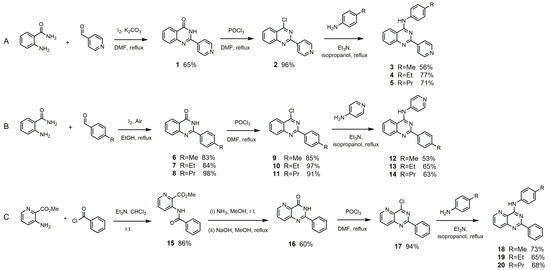
Scheme 1.
The synthesis of the first set of target compounds. (A) Synthesis of compounds 3–5. (B) Synthesis of compounds 12–14. (C) Synthesis of compounds 18–20.
Compound 16 could not be readily obtained successfully from 3-aminopicolinamide iodine catalysis. Therefore, a two-step synthesis starting with methyl-3-aminopicolinate was used to obtain 16 via Compound 15, as shown in Scheme 1C. Acylation of the amino group of methyl 3-aminopicolinate with benzoyl chloride provided benzamidopicolinate 15. Treatment of 15 with aqueous ammonium hydroxide followed by cyclization with aqueous sodium hydroxide provided quinazolinone 16 in 60% yield [24]. Chlorination followed by reaction with substituted anilines led to target compounds 18–20 in 65–73% yields in 65–73% yields.
Based on the MTT assay results, quinazolinamine derivatives 4 and 5 with scaffold A showed higher potency as BCRP inhibitors than those with scaffolds B or C, decreasing the IC50 values of mitoxantrone from 5.66 µM to 0.27 and 0.23 µM, respectively (Table 1). Based on these preliminary results, additional quinazolinamine derivatives with scaffold A (Scheme 2) were designed to discover more potent BCRP inhibitors with a potential to also inhibit P-gp. BCRP and P-gp inhibitory activities of all quinazolinamine derivatives were determined to investigate the SAR. Compound 21 with no substitution on ring A was designed for comparison. It was reported that quinazolinamines with substitutions at meta and para positions were more potent than those with substitutions at the ortho position. Two and three carbon substitutions were made at meta and para positions to obtain target compounds 22–25. The inhibitory activities of these compounds were compared with those of the ethyl- and propyl-substituted compounds 4 and 5. The 3-NO2-4-OH-substituted quinazolinamine has been previously shown to exhibit potent inhibition toward the BCRP transporter [9]. To further investigate the SAR of the quinazolinamine series with scaffold A, the 3-NO2-4-OH moiety was introduced in target Compound 26 to probe the effects of the electron withdrawing and donating groups on the reversal activities of quinazolinamines towards BCRP and P-gp transporters. Compounds 27, 28 and 29 with methoxy, amine and pyridine groups were included to explore the effect of polarity on the inhibitory activities. The quinazolinamine derivatives with electrophilic (30–31), non-electrophilic control (32), or photoaffinity label (33) were designed for the investigation of potential covalent bonding between quinazolinamines and ABC transporters.

Table 1.
The reversal effects of quinazolinamine derivatives 3–5, 12–14, and 18–20 on BCRP-mediated MDR cell line H460/MX20.
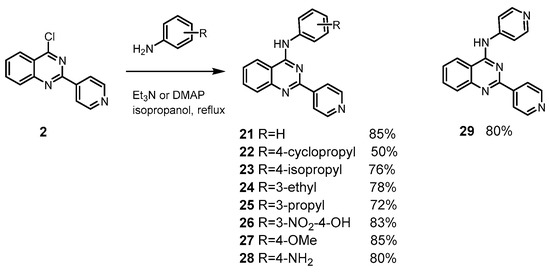
Scheme 2.
The synthesis of 21–29.
Target compounds 21–29 (Scheme 2) were synthesized from Compound 2 in a similar fashion as Compounds 3–5. A nucleophilic aromatic substitution of the 4-chloroquinazolinamine derivatives with various substituted anilines was carried out to obtain the desired quinazolinamines 21–29. Amino derivative 28 was used to synthesize 30–33 (Scheme 3) by reacting with di(2-pyridyl) thionocarbonate, bromoacetyl bromide, acetic anhydride, sodium nitrite and sodium azide, respectively.
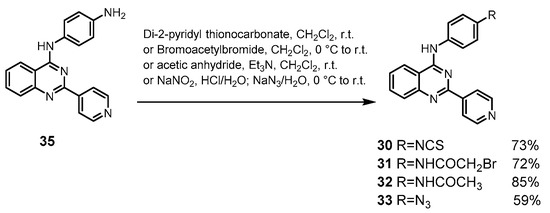
Scheme 3.
The synthesis of 30–33.
3.2. Cytotoxicity and Reversal Study on BCRP
The cytotoxicities of quinazolinamine derivatives were tested to determine the concentration of the quinazolinamines needed for reversal studies. Quinazolinamine derivatives 3–5, 12–14, and 18–20 exhibited low to moderate cytotoxicity toward the parental H460 and BCRP-overexperssing H460/MX20 cell lines. The compounds at 5 μM decreased the viability of H460 (Figure S1) and H460/MX20 (Figure S2) cell lines by less than 20%. Next, the reversal assays were conducted on drug resistant H460/MX20 cell line at 5 μM concentration of the quinazolinamine derivatives 3–5, 12–14, and 18–20. Based on the MTT assay (Table 1), ethyl- and propyl-substituted derivatives 4 and 5 exhibited the strongest reversal activities on BCRP-mediated multidrug resistance. Mitoxantrone is a known BCRP substrate. The IC50 value of MX on H460 and H460/MX20 are 0.072 μM and 5.66 μM, respectively. When combined with the majority of the quinazolinamine derivatives, the IC50 value of MX on H460/MX20 decreased. Ko143, a known BCRP inhibitor, can effectively decrease the IC50 value of MX on H460/MX20 to 0.18 μM. The efficacies of Compounds 4 and 5 with Scaffold A are comparable to Ko143, decreasing the IC50 values of MX on H460/MX20 to 0.27 μM and 0.23 μM, respectively.
MTT assays on target compounds 21–33 were conducted to determine whether these quinazolinamine derivatives at the concentration of 5 μM were non-toxic to H460 (Figure S1) and H460/MX20 cell lines (Figure S2). The results showed that the derivatives at 5 μM did not decrease the viability of H460 and H460/MX20 cells by more than 20%. Thus, the reversal activities of quinazolinamine derivatives were determined at 5 μM. Target compounds 22–25 and 27 were found to be most potent with potencies similar to those of 4 or 5 (Table 2). The IC50 value of mitoxantrone was found to be 0.42 μM when combined with 33 (5 μM), but upon UV activation of 33 at 254 nm, the IC50 value decreased to 0.19 μM. It is hypothesized that the covalent bonding of 33 with BCRP will lead to reduced off-target effects. Gefitinib showed the most potent inhibition on BCRP, decreasing the IC50 value of mitoxantrone to 0.13 μM.

Table 2.
The reversal effects of quinazolinamine compounds 21–33 on BCRP-mediated MDR cell line H460/MX20.
3.3. Cytotoxicity and Reversal Study on P-gp
Inhibitory activities of the quinazolinamines derivatives 3–5, 12–14, and 18–33 on P-gp were studied to investigate the selectivity of these compounds. The quinazolinamine derivatives exhibited low cytotoxicity at the concentration of 5 μM toward the parental KB-3-1 (Figure S3) and P-gp-overexperssing KB-C2 (Figure S4) cell lines. These compounds did not decrease the viability of the KB-3-1 and KB-C2 cells by more than 20%. Hence, the reversal assays were conducted on the drug-resistant KB-C2 cell line with the quinazolinamine derivatives at the concentration of 5 μM. The results indicated that compounds 4–5, 13, 22–25, and 27 exhibited potent P-gp inhibition (Figure 3). When these quinazolinamines were combined with the P-gp substrate, colchicine (0.5 μM), the survival rate of KB-C2 cells dramatically decreased, compared to the colchicine alone. Therefore, these eight compounds were further investigated, and it was found that compounds 4–5, 22–24, 27 exhibited higher potency than verapamil and gefitinib (Figure 4). The results indicated that in combination with compounds 4–5, 22–24, 27, the IC50 values of colchicine on KB-C2 cells were decreased dramatically from 7.34 μM to lower than 0.30 μM, while verapamil and gefitinib decreased the IC50 value of colchicine to 0.43 and 0.55 μM, respectively. In addition, azide derivative 33 did not show potent inhibition on the P-gp with IC50 value of 6.05 μM for colchicine after the combination.
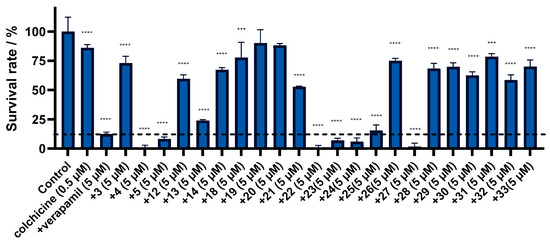
Figure 3.
The inhibition of all the quinazolinamine compounds on P-gp-mediated multidrug-resistant cell line KB-C2. The statistical significances between the treatment groups and the control group were indicated as follows: ***, p < 0.001; ****, p < 0.0001, two-way ANOVA, indicating the statistical significances between the control group and the treatment groups, two-way ANOVA.
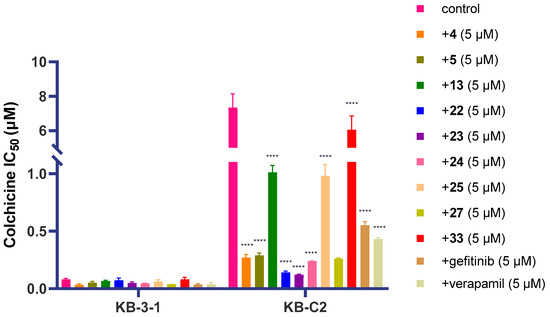
Figure 4.
The reversal study of nine quinazolinamine compounds on P-gp-mediated multidrug resistant cell line KB-C2. The statistical significances between the treatment groups and the control group were indicated as follows: ****, p < 0.0001, two-way ANOVA, indicating the statistical significances between the control group and the treatment groups, two-way ANOVA.
3.4. Metabolic Stability Study of Quinazolinamine Derivatives
Ko143, as a potent BCRP inhibitor, is widely used as a positive control in the scientific research. However, Ko143 has limitation for clinical use due to the low metabolic stability in vivo [25]. Therefore, the design of metabolically more stable reversal agents for BCRP-mediated MDR is highly desired. Human liver microsomes contain a wide variety of membrane-bound drug-metabolizing CYP450 enzymes [26], derived from the human liver, where the drugs are mainly metabolized. Thus, in vitro metabolic stability testing with human liver microsomes has been commonly used to predict the in vivo hepatic metabolism of the drugs in the human body [27].
The potent BCRP and P-gp dual inhibitors 4–5, 22–24, 27, and potent BCRP inhibitor 33 were selected for a metabolic stability study. The results showed that 80–92% of the seven quinazolinamine derivatives remained intact after 1 h of incubation with human liver microsomes, indicating higher metabolic stability than Ko143 (Table 3). Thus, these quinazolinamines can serve as valuable pharmacologic tools in the future. Significantly, 92% of cyclopropyl derivative 22 remained after incubation with human liver microsomes compared to 41% of Ko143. It has been reported that the cyclopropyl group can enhance potency, reduce off-target effects, increase metabolic stability, increase brain permeability, decrease plasma clearance, contribute to an entropically more favorable binding to the receptor, restrict the conformation of peptides/peptidomimetics to prevent proteolytic hydrolysis, and alter drug pKa [28]. Since the results showed that 22 is a potent BCRP and P-gp inhibitor with high metabolic stability, it was selected for investigation of its mechanism in reversing the multidrug resistance mediated by BCRP and P-gp. In addition, azide derivative 33, which was found to be a potent BCRP inhibitor, was selected for further investigation to learn about the binding mode of quinazolinamines to BCRP protein.

Table 3.
Metabolic stability of selected quinazolinamine derivatives with human liver microsomes.
3.5. The Reversal Study of 22 and 33 in Combination with Anticancer Drugs
Reversal studies were conducted to further investigate the effects of 22 and 33 in combination with BCRP substrate, mitoxantrone; P-gp substrate, paclitaxel; and non-substrate, cisplatin. The results showed that the reversal effect of 22 (VKCY-1) on P-gp was not limited to one substrate (Figure 5A). It could sensitize KB-C2 cells to the anticancer drug, paclitaxel, in addition to colchicine. A non-BCRP or P-gp substrate cisplatin, was used as a negative control (Figure 5B,C). The results suggested that the sensitizing effects of Compounds 22 (VKCY-1) and 33 (VKCY-2) were limited to BCRP and/or P-gp substrates for ABC-transporter-mediated MDR cancer cell lines.
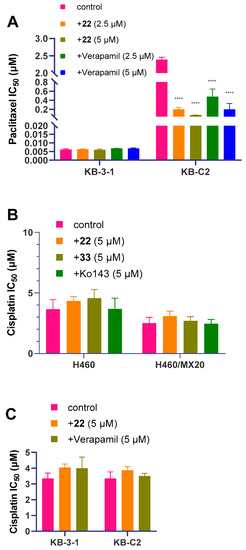
Figure 5.
The reversal study of 22 and 33 in combination with anticancer drugs. (A) The reversal study of 22 with paclitaxel on P-gp-mediated multidrug-resistant cell line KB-C2. (B) The reversal study of 22 and 33 with cisplatin on BCRP-mediated multidrug-resistant cell line H460/MX20. (C) The reversal study of 22 with cisplatin on P-gp-mediated multidrug-resistant cell line KB-C2. The statistical significances between the treatment groups and the control group were indicated as follows: ****, p < 0.0001, two-way ANOVA, indicating the statistical significances between the control group and the treatment groups, two-way ANOVA.
3.6. The Effect of 22 and 33 on Anticancer Drugs Accumulation
The reversing of multidrug resistance can be achieved through various mechanisms, such as direct binding to P-gp, inhibiting ATPase activity, or altered expression level or localization of ABC transporter proteins. Previous reports indicated that several tyrosine kinase inhibitors (TKIs), such as gefitinib, imatinib nilotinib, and erlotinib, inhibited BCRP-mediated drug resistance. These TKIs themselves are BCRP substrates and may act as competitive BCRP inhibitors to block the efflux of anticancer drugs. In contrast, protein kinase C (PKC) inhibitors can inhibit BCRP or P-gp ATPase activity to suppress drug resistance.
Drug accumulation assays were conducted to determine the effects of cyclopropyl derivative 22 and azide derivative 33 on the accumulation of mitoxantrone in H460 and H460/MX20 cells, or paclitaxel in KB-3-1 and KB-C2 cells. The results of the accumulation assay showed that both cyclopropyl derivative 22 and azide 33 can slightly increase the accumulation of mitoxantrone in parental H460 cells (Figure 6A). Since a low level of BCRP transporter is expressed in H460 cells, 22 and 33 can also inhibit the efflux function of BCRP in H460 cell. In addition, the two compounds increased the accumulation of mitoxantrone in resistant H460/MX20 cells, which overexpressed BCRP transporter. Treatment of 33 followed by UV light activation, showed that the accumulation of mitoxantrone was increased compared to the group without activation. It explained the reason why the IC50 value of mitoxantrone for the activated 33 treatment group (Table 2) was lower than that of the inactivated 33 treatment group. In addition, 22 did not increase the accumulation of paclitaxel in the parental cells KB-3-1, while 22 significantly increased the accumulation of paclitaxel in resistant cell line KB-C2 (Figure 6B). When in combination with 22 or 33, the accumulation of mitoxantrone and paclitaxel in MDR cells were enhanced and the viability of cancer cells decreased. This explained why the IC50 values of mitoxantrone and paclitaxel decreased when they were combined with 22 or 33.
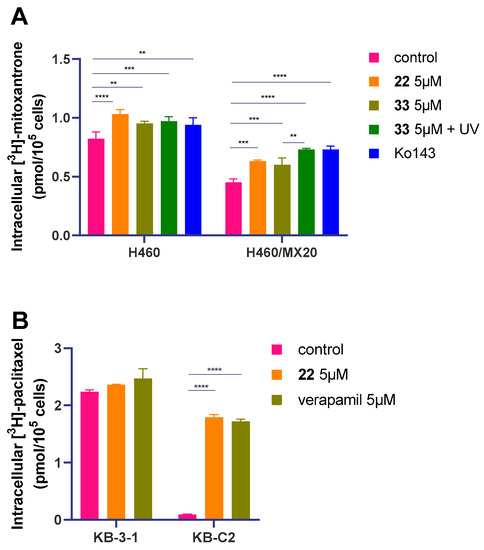
Figure 6.
The effect of 22 and 33 on the accumulation of mitoxantrone on H460/MX20 (A) or paclitaxel on KB-C2 cells (B). Ko143 and verapamil were used as positive controls. The statistical significances between the treatment groups and the control group were indicated as follows: **, p < 0.01, ***, p < 0.001; ****, p < 0.0001, two-way ANOVA, indicating the statistical significances between the control group and the treatment groups, two-way ANOVA.
3.7. The Effect of 22 and 33 on BCRP and P-gp Expression Level in Cells
Western blot assays were conducted to study the effects of 22 and 33 on the expression level of BCRP or P-gp proteins. Compound 22 did not change the expression level of BCRP protein on H460/MX20 cells, nor did it change the P-gp protein expression on KB-C2 cells (Figure 7A,B). The BCRP expression level on H460/MX20 cells was not altered by 33 (Figure 7C). Thus, it was concluded that blocking the efflux function of BCRP or P-gp was not due to the downregulation of the expression level.
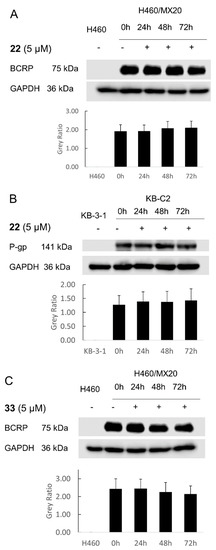
Figure 7.
The effect of 22 and 33 on BCRP and P-gp expression level in drug-resistant cell lines. (A) The effect of 22 on BCRP expression in H460/MX20 cells. (B) The effect of 22 on P-gp expression in KB-C2 cells. (C) The effect of 33 on BCRP expression in H460/MX20 cells.
3.8. The Effect of 22 and 33 on the Localization of BCRP and P-gp
The immunofluorescence assays were conducted to determine the effects of 22 and 33 on the localization of BCRP or P-gp proteins. BCRP protein is expressed on the membranes of drug-resistant cells H460/MX20 and the P-gp protein is expressed on the membranes of KB-C2 cells in the control groups (Figure 8A,B). With the incubation of 22 (5 μM) for 24, 48, and 72 h, the fluorescence on the membranes of H460/MX20 decreased gradually. With the treatment of 22 (5 μM) for 24 and 48 h, the fluorescence on the membranes of KB-C2 cells did not decrease significantly, while the fluorescence decreased slightly at 72 h. Since 22 does not change the expression level of BCRP and P-gp protein based on the Western blot analysis, it was hypothesized that the intracellular localization of the ABC transporters on both H460/MX20 and KB-C2 cells were altered by 22. The alteration of the ABC transporters’ localization can result in the loss of the efflux function of ABC-transporters in MDR cells. Thus, the anticancer drugs can be accumulated in the cells, and effectively killing them. Interestingly, 33 did not change the intracellular localization of BCRP on H460/MX20 cells (Figure 8C). The reversal effect of 33 on BCRP can be due to other mechanisms instead of the alteration of the BCRP localization.
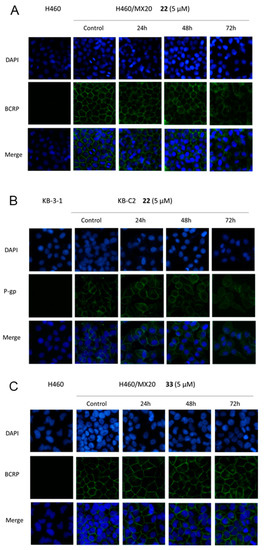
Figure 8.
The effect of quinazolinamine derivatives on BCRP and P-gp localization. (A) The effect of 22 on BCRP localization in H460 and H460/MX20 cells. (B) The effect of 22 on P-gp localization in KB-3-1 and KB-C2 cells. (C) The effect of 33 on BCRP localization in H460 and H460/MX20 cells.
3.9. The Effect of 22 on BCRP and P-gp Expression Level at the Plasma Membrane and Intracellular Organelles
To further investigate whether 22 affects the localization of BCRP and P-gp, the proteins were extracted from the membrane and cytoplasm of the cells, respectively. It was found that 22 decreased the expression level of BCRP protein on the membrane of H460/MX20 cells. On the other hand, the BCRP protein expression level in the cytoplasm was increased by target Compound 22 (Figure 9A,B). Compound 22 showed a similar effect on the P-gp protein expression of the KB-C2 cells (Figure 9C,D) that the expression level of the P-gp protein on the membrane slightly decreased and the cytoplasmic P-gp slightly increased through the quantifications with Image J. These results revealed that 22 can translocate BCRP or P-gp protein from the membrane to the cytoplasm.
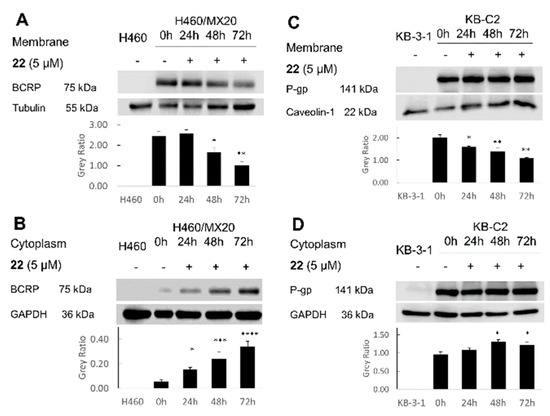
Figure 9.
The effect of 22 on BCRP and P-gp expression level in plasma membrane and intracellular organelles. (A) The effect of 22 on BCRP expression level in membrane of H460/MX20 cells. (B) The effect of 22 on BCRP expression level in cytoplasm of H460/MX20 cells. (C) The effect of 22 on P-gp expression level in membrane of KB-C2 cells. (D) The effect of 22 on P-gp expression level in cytoplasm of KB-C2 cells. The statistical significances between the treatment groups and the control group were indicated as follows: *, p < 0.05, **, p < 0.01, ***, p < 0.001; ****, p < 0.0001, two-way ANOVA, indicating the statistical significances between the control group and the treatment groups, two-way ANOVA.
3.10. The Effect of 22 and 33 on BCRP and P-gp ATPase
ATPase assays were conducted to determine whether 22 and 33 affect the BCRP or P-gp ATPase activities. The results of ATPase assay showed that both 22 (Figure 10A) and 33 (Figure 10B) were most likely substrates of the BCRP transporter. Therefore, they could act as potential competitive substrates, thus blocking the efflux of anticancer drugs and increasing the accumulation of anticancer drugs. The results indicated that 22 (Figure 10C) can neither stimulate or inhibit the P-gp ATPase; thus, it is not the substrate or inhibitor of BCRP. From the results of the Western blot and ATPase assay, 22 did not change the P-gp protein expression level and did not affect the P-gp ATPase activity. Therefore, 22 likely reverses the P-gp-mediated MDR by altering the localization of P-gp on MDR cancer cells.
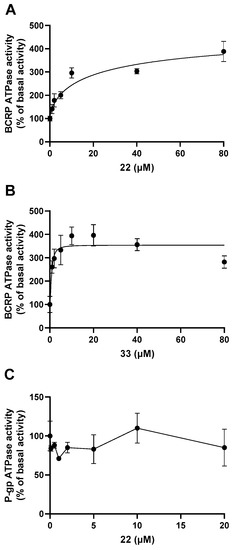
Figure 10.
The effect of 22 and 33 on orthovanadate (Vi)-sensitive ATPase activity of BCRP and P-gp. (A) The effect of 22 on Vi-sensitive BCRP ATPase activity. (B) The effect of 33 on Vi-sensitive BCRP ATPase activity. (C) The effect of 22 on Vi-sensitive P-gp ATPase activity.
3.11. Docking Analysis of 22 and 33 with BCRP and P-gp
The Glide docking scores of 22, 33, and Ko143 binding with BCRP (PDB 6FFC) are −11.123, −10.403 and −12.017 kcal/mol, respectively (Figure 11). The quinazoline ring and the pyridine ring of 22 interacted with the Phe439 of the BCRP model through π-π interactions. The amino group of 22 formed a hydrogen bond with the carbonyl group in the side chain of Asn436 (Figure 11A,D). The quinazoline ring of 33 interacted with the Phe439 of the BCRP model through π-π interactions (Figure 11B,E). The nitrogen in the pyridine ring of 33 formed a hydrogen bond with the amino group in the side chain of Asn436. The amino group of Ko143 interacted with the carbonyl group in the side chain of Asn436 through a hydrogen bond. The carbonyl group of Ko143 formed a hydrogen bond with the hydroxyl group of Thr542. (Figure 11C,F). Compounds 22 and 33 were stabilized into a pocket formed by residues Phe432, Thr435, Thr542, Val546, and Met549 of BCRP. The Glide docking scores of 22 and verapamil binding with P-gp (PDB 7A6E) [23] were −8.288 and −7.774 kcal/mol, respectively (Figure 12). The quinazoline ring of 22 interacted with Phe343 and Trp232 of the P-gp model through π-π interactions. The tertiary amine of verapamil can become a cation in cancers due to the acidic tumor microenvironment [29] and form a salt bridge with the side chain of Glu875 in P-gp.
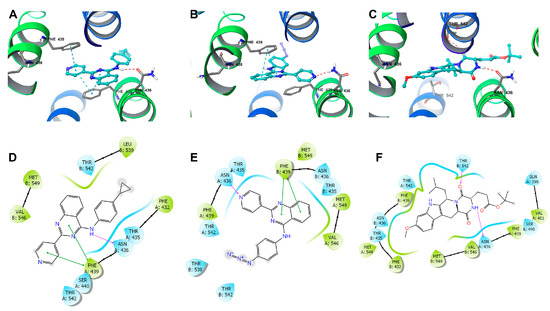
Figure 11.
The docking analysis of 22, 33, and Ko143 binding with BCRP (PDB 6FFC). (A) Docked position of Compound 22 within the binding site of the human BCRP transporter. Compound 22 is shown as a ball-and-stick model, with the atoms colored as follows: carbon is cyan, hydrogen is white, nitrogen is blue, and oxygen is red. The important residues are depicted as sticks with the same color scheme as above except that the carbons are indicated by the gray color. Ring centroids were represented as dark green dots. Dotted red lines indicate hydrogen bonds. (D) A two-dimensional ligand–receptor interaction diagram shows the important interactions of Compound 22 with the binding site residues of human BCRP. The amino acids are shown as colored bubbles, cyan indicates polar residues and green indicates hydrophobic residues. Hydrogen bonds are indicated by the purple dotted arrow, and p-p stacking aromatic interactions are indicated by the green lines. (B) Docked position of Compound 33 within the binding site of the human BCRP transporter. (E) A two-dimensional ligand–receptor interaction diagram shows the important interactions of Compound 33 with the binding site residues of the human BCRP. (C) Docked position of Ko143 within the binding site of the human BCRP. (F) A two-dimensional diagram shows the important contacts of Ko143 with the binding site residues of the human BCRP transporter.
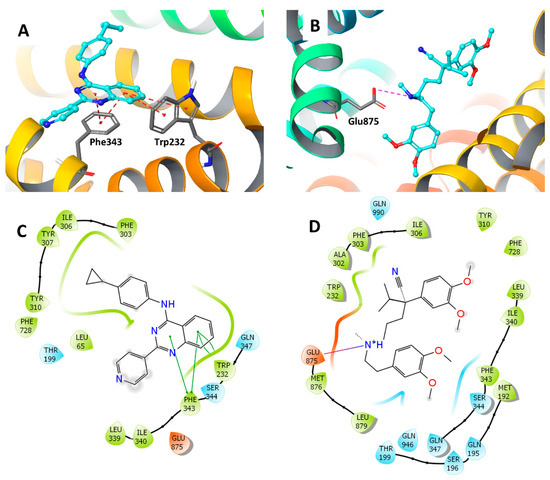
Figure 12.
The docking analysis of 22 and verapamil binding with human P-gp (PDB 7AE6). The color scheme is consistent with Figure 11. (A) Docked position of Compound 22 within the binding site of the human P-gp model. (B) Docked position of verapamil within the binding site of the human P-gp model. Cation-π interaction is indicated by the green dotted line. (C) A two-dimensional ligand–receptor interaction diagram shows the important interactions of Compound 22 with the binding site residues of human P-gp. (D) A two-dimensional ligand–receptor interaction diagram shows the important interactions of verapamil with the binding site residues of human P-gp. Cation-π interaction is indicated by dotted red line.
4. Conclusions
In this study, twenty-two quinazolinamine derivatives were synthesized, and their reversal activities for BCRP- and P-gp-mediated MDR were determined. Based on the SAR, quinazolinamines with scaffold A were more potent BCRP inhibitors than those with scaffolds B or C. The results indicated that alkyl substituted quinazolinamine analogues 4–5, 13, 22–25, and methoxy quinazolinamine 27 are potent BCRP and P-gp dual inhibitors with a potential to reverse MDR by blocking the efflux of anticancer drugs. In addition, selected quinazolinamine derivatives (4–5, 22–24, 27, and 33) that were investigated for metabolic stability exhibited higher metabolic stability than Ko143. Cyclopropyl quinazolinamine 22 potently inhibited both BCRP- and P-gp, significantly increased the accumulation of mitoxantrone in BCRP-overexpressing H460/MX20 cells, or paclitaxel in KB-C2 cells with P-gp overexpression. The results indicated that 22 changed the localization of BCRP in H460/MX20 cells and P-gp in KB-C2 cells but did not alter the expression level of BCRP or P-gp, thus blocking the efflux function of ABC transporters. In addition, the stimulation of ATP hydrolysis of BCRP by 22 can be another mechanism for reversing the BCRP-mediated MDR. Interestingly, compared to 22, azide quinazolinamine 33 is a BCRP inhibitor with a different mechanism in that it does not alter the localization of BCRP protein. In addition, 33 did not change the BCRP protein expression level. The ATPase results showed that 33 significantly stimulated the ATP hydrolysis of BCRP transporter indicating it could be a competitive substrate of the BCRP transporter to block the efflux of anticancer drugs. Azide quinazolinamine 33 with a photoaffinity label can be activated by UV light and may covalently bind with the BCRP transporter. Thus, it can serve as a probe to investigate the binding site of quinazolinamine derivatives on the BCRP protein. From the molecular-modeling results, quinazolinamines 22 and 33 showed high docking scores when docked with human BCRP and/or the P-gp model, indicating the high affinity between 22, 33 and BCRP and/or P-gp protein. The interactions between 22 and 33 and the important residues can be important clues for the further modification of quinazolinamine derivatives. These results give insight into the rational design of quinazolinamines reversing BCRP and P-gp-mediated MDR in cancers.
Supplementary Materials
The following supporting information can be downloaded at: https://www.mdpi.com/article/10.3390/biom13020253/s1, Figure S1: The cytotoxicities of quinazolinamine derivatives 3–5, 12–14, and 18–33 on H460 cell lines; Figure S2: The cytotoxicities of quinazolinamine derivatives 3–5, 12–14, and 18–33 on H460/MX20 cell lines; Figure S3: The cytotoxicities of quinazolinamine derivatives 3–5, 12–14, and 18–33 on KB-3-1 cell lines; Figure S4: The cytotoxicities of quinazolinamine derivatives 3–5, 12–14, and 18–33 on KB-C2 cell lines; Figure S5: 1H NMR (400 MHz, d6-DMSO) of 1; Figure S6: 1H NMR (400 MHz, d6-DMSO) of 2; Figure S6: 1H NMR (400 MHz, d6-DMSO) of 2; Figure S7: HPLC analysis of 3; Figure S8: IR spectra of 3; Figure S9: 1H NMR (400 MHz, d6-DMSO) of 3; Figure S10: 13C NMR (101 MHz, d6-DMSO) of 3; Figure S11: HPLC analysis of 4; Figure S12: IR spectra of 4; Figure S13: 1H NMR (400 MHz, d6-DMSO) of 4; Figure S14: 13C NMR (101 MHz, d6-DMSO) of 4; Figure S15: HPLC analysis of 5; Figure S16: IR spectra of 5; Figure S17: 1H NMR (400 MHz, d6-DMSO) of 5; Figure S18: 13C NMR (101 MHz, d6-DMSO) of 5; Figure S19: 1H NMR (400 MHz, d6-DMSO) of 6; Figure S20: 1H NMR (400 MHz, d6-DMSO) of 7; Figure S21: 1H NMR (400 MHz, d6-DMSO) of 8; Figure S22: 1H NMR (400 MHz, d6-DMSO) of 9; Figure S23: 1H NMR (400 MHz, d6-DMSO) of 10; Figure S24: 1H NMR (400 MHz, d6-DMSO) of 11; Figure S25: HPLC analysis of 12; Figure S26: IR spectra of 12; Figure S27: 1H NMR (400 MHz, d6-DMSO) of 12; Figure S28: 13C NMR (101 MHz, d6-DMSO) of 12; Figure S29: HPLC analysis of 13; Figure S30: IR spectra of 13; Figure S31. 1H NMR (400 MHz, d6-DMSO) of 13; Figure S32: 13C NMR (101 MHz, d6-DMSO) of 13; Figure S33: HPLC analysis of 14; Figure S34: IR spectra of 14; Figure S35: 1H NMR (400 MHz, d6-DMSO) of 14; Figure S36: 13C NMR (101 MHz, d6-DMSO) of 14; Figure S37: 1H NMR (400 MHz, d6-DMSO) of 15; Figure S38: 1H NMR (400 MHz, d6-DMSO) of 16; Figure S39: 1H NMR (400 MHz, d6-DMSO) of 17; Figure S40: HPLC analysis of 18; Figure S41: IR spectra of 18; Figure S42: 1H NMR (400 MHz, d6-DMSO) of 18; Figure S43: 13C NMR (101 MHz, d6-DMSO) of 18; Figure S44: HPLC analysis of 19; Figure S45: IR spectra of 19; Figure S46: 1H NMR (400 MHz, d6-DMSO) of 19; Figure S47: 13C NMR (101 MHz, d6-DMSO) of 19; Figure S48: HPLC analysis of 20; Figure S49: IR spectra of 20; Figure S50: 1H NMR (400 MHz, d6-DMSO) of 20; Figure S51: 13C NMR (101 MHz, d6-DMSO) of 20; Figure S52: HPLC analysis of 21; Figure S53: IR spectra of 21; Figure S54: 1H NMR (400 MHz, d6-DMSO) of 21; Figure S55: 13C NMR (101 MHz, d6-DMSO) of 21; Figure S56: HPLC analysis of 22; Figure S57: IR spectra of 22; Figure S58: 1H NMR (400 MHz, d6-DMSO) of 22; Figure S59: 13C NMR (101 MHz, d6-DMSO) of 22; Figure S60: HPLC analysis of 23; Figure S61: IR spectra of 23; Figure S62: 1H NMR (400 MHz, d6-DMSO) of 23; Figure S63: 13C NMR (101 MHz, d6-DMSO) of 23; Figure S64: HPLC analysis of 24; Figure S65: IR spectra of 24; Figure S66: 1H NMR (400 MHz, d6-DMSO) of 24; Figure S67: 13C NMR (101 MHz, d6-DMSO) of 24; Figure S68: HPLC analysis of 25; Figure S69: IR spectra of 25; Figure S70: 1H NMR (400 MHz, d6-DMSO) of 25; Figure S71: 13C NMR (101 MHz, d6-DMSO) of 25; Figure S72: HPLC analysis of 26; Figure S73: IR spectra of 26; Figure S74: 1H NMR (400 MHz, d6-DMSO) of 26; Figure S75: 13C NMR (101 MHz, d6-DMSO) of 26; Figure S76: HPLC analysis of 27; Figure S77: IR spectra of 27; Figure S78: 1H NMR (400 MHz, d6-DMSO) of 27; Figure S79: 13C NMR (101 MHz, DMSO) of 27; Figure S80: HPLC analysis of 28; Figure S81: IR spectra of 28; Figure S82: 1H NMR (400 MHz, d6-DMSO) of 28; Figure S83: 13C NMR (101 MHz, d6-DMSO) of 28; Figure S84: HPLC analysis of 29; Figure S85: IR spectra of 29; Figure S86: 1H NMR (400 MHz, d6-DMSO) of 29; Figure S87: 1H NMR (400 MHz, d6-DMSO) of 29, exchange with D2O; Figure S88: 13C NMR (101 MHz, d6-DMSO) of 29; Figure S89: HPLC analysis of 30; Figure S90: IR spectra of 30; Figure S91: 1H NMR (400 MHz, d6-DMSO) of 30; Figure S92: 13C NMR (101 MHz, d6-DMSO) of 30; Figure S93: HPLC analysis of 31; Figure S94: IR spectra of 31; Figure S95: 1H NMR (400 MHz, d6-DMSO) of 31; Figure S96: 13C NMR (101 MHz, d1-CF3COOD) of 31; Figure S97: HPLC analysis of 32; Figure S98: IR spectra of 32; Figure S99: 1H NMR (400 MHz, d6-DMSO) of 32; Figure S100: 13C NMR (101 MHz, d6-DMSO) of 32; Figure S101: HPLC analysis of 33; Figure S102: IR spectra of 33; Figure S103: 1H NMR (400 MHz, d6-DMSO) of 33; Figure S104: 13C NMR (101 MHz, d6-DMSO) of 33.
Author Contributions
C.-Y.C. contributed to the experimental design, interpreted results, and was mostly responsible for writing the manuscript. Q.-X.T., M.M. and S.V.A. contributed to the ATPase assay. V.L.K. and Z.-S.C. supervised the project and revised the manuscript. All authors contributed to the writing of the manuscript. All authors have read and agreed to the published version of the manuscript.
Funding
This research received no external funding.
Institutional Review Board Statement
Not applicable.
Informed Consent Statement
Not applicable.
Data Availability Statement
Not applicable.
Acknowledgments
We thank Dr. Susan E. Bates (Columbia University, New York, NY, USA) and Dr. Robert W. Robey (NCI, NIH, MD, USA) for generously providing us the H460, H460/MX20. We thank Dr. Shin-ichi Akiyama (Kagoshima University, Kagoshima, Japan) for kindly providing us the KB-3-1 and KB-C2 cell lines. We are thankful to Dr. Tanaji T. Talele (St. John’s University, Queens, NY, USA) providing us the support for the docking study. This work was supported by the Department of Pharmaceutical Science at St. John’s University. M.M. and S.V.A. were funded by the Intramural Program of the National Institutes of Health, National Cancer Institute, Center for Cancer Research. The graphic abstract was created with BioRender.com.
Conflicts of Interest
The authors declare no competing interest.
References
- Nakanishi, T.; Ross, D.D. Breast cancer resistance protein (BCRP/ABCG2): Its role in multidrug resistance and regulation of its gene expression. Chin. J. Cancer 2012, 31, 73–99. [Google Scholar] [CrossRef] [PubMed]
- Doyle, L.A.; Yang, W.; Abruzzo, L.V.; Krogmann, T.; Gao, Y.; Rishi, A.K.; Ross, D.D. A multidrug resistance transporter from human MCF-7 breast cancer cells. Proc. Natl. Acad. Sci. USA 1998, 95, 15665–15670. [Google Scholar] [CrossRef]
- Rabindran, S.K.; Ross, D.D.; Doyle, L.A.; Yang, W.; Greenberger, L.M. Fumitremorgin C reverses multidrug resistance in cells transfected with the breast cancer resistance protein. Cancer Res. 2000, 60, 47–50. [Google Scholar] [PubMed]
- Allen, J.D.; Van Loevezijn, A.; Lakhai, J.M.; Van Der Valk, M.; Van Tellingen, O.; Reid, G.; Schellens, J.H.M.; Koomen, G.-J.; Schinkel, A.H. Potent and specific inhibition of the breast cancer resistance protein multidrug transporter in vitro and in mouse intestine by a novel analogue of fumitremorgin C. Mol. Cancer Ther. 2002, 1, 417–425. [Google Scholar] [PubMed]
- Weidner, L.D.; Zoghbi, S.S.; Lu, S.; Shukla, S.; Ambudkar, S.V.; Pike, V.W.; Mulder, J.; Gottesman, M.M.; Innis, R.B.; Hall, M.D. The Inhibitor Ko143 Is Not Specific for ABCG2. J. Pharmacol. Exp. Ther. 2015, 354, 384–393. [Google Scholar] [CrossRef] [PubMed]
- Yanase, K.; Tsukahara, S.; Asada, S.; Ishikawa, E.; Imai, Y.; Sugimoto, Y. Gefitinib reverses breast cancer resistance protein–mediated drug resistance. Mol. Cancer Ther. 2004, 3, 1119–1125. [Google Scholar] [CrossRef] [PubMed]
- Kitazaki, T.; Oka, M.; Nakamura, Y.; Tsurutani, J.; Doi, S.; Yasunaga, M.; Takemura, M.; Yabuuchi, H.; Soda, H.; Kohno, S. Gefitinib, an EGFR tyrosine kinase inhibitor, directly inhibits the function of P-glycoprotein in multidrug resistant cancer cells. Lung Cancer 2005, 49, 337–343. [Google Scholar] [CrossRef]
- Krapf, M.K.; Gallus, J.; Wiese, M. Synthesis and biological investigation of 2,4-substituted quinazolines as highly potent inhibitors of breast cancer resistance protein (ABCG2). Eur. J. Med. Chem. 2017, 139, 587–611. [Google Scholar] [CrossRef]
- Krapf, M.K.; Gallus, J.; Spindler, A.; Wiese, M. Synthesis and biological evaluation of quinazoline derivatives—A SAR study of novel inhibitors of ABCG2. Eur. J. Med. Chem. 2019, 161, 506–525. [Google Scholar] [CrossRef]
- Liu, X. ABC Family Transporters. In Drug Transporters in Drug Disposition, Effects and Toxicity; Springer: Singapore, 2019; Volume 1141, pp. 13–100. [Google Scholar] [CrossRef]
- Hu, Y.; Hou, H.; Yu, L.; Zhou, S.; Wu, X.; Sun, W.; Ke, F. Electro-oxidative cyclization: Access to quinazolinones via K2S2O8 without transition metal catalyst and base. RSC Adv. 2021, 11, 31650–31655. [Google Scholar] [CrossRef]
- Shaifali; Mehara, P.; Kumar, A.; Das, P. Pd/C Catalyzed Cascade Synthesis of 2-Arylquinazolinones from 2-Iodoacetanilides Employing Ammonia and CO Precursors. Chemcatchem 2021, 13, 2459–2464. [Google Scholar] [CrossRef]
- Barros, I.d.C.L.; Bejan, C.C.C.; da Silva, J.B.P.; Demnitz, F.W.J.; Hallwass, F.; Gremlich, H.-U. Conformational studies on 1,2-di- and 1,2,3-trisubstituted heterocycles. A spectroscopic and theoretical study of 3-acylaminopicolinic Acid derivatives and their N-oxides. J. Org. Chem. 2002, 67, 370–382. [Google Scholar] [CrossRef] [PubMed]
- Irwin, W.J.; Wibberley, D.G. 782. Pyrido[3,2-d]pyrimidin-4(3H)-ones. J. Chem. Soc. 1965, 4240–4246. [Google Scholar] [CrossRef]
- Carmichael, J.; DeGraff, W.G.; Gazdar, A.F.; Minna, J.D.; Mitchell, J.B. Evaluation of a tetrazolium-based semiautomated colorimetric assay: Assessment of chemosensitivity testing. Cancer Res. 1987, 47, 936–942. [Google Scholar] [PubMed]
- Tung, Y.-S.; Coumar, M.S.; Wu, Y.-S.; Shiao, H.-Y.; Chang, J.-Y.; Liou, J.-P.; Shukla, P.; Chang, C.-W.; Chang, C.-Y.; Kuo, C.-C.; et al. Scaffold-Hopping Strategy: Synthesis and Biological Evaluation of 5,6-Fused Bicyclic Heteroaromatics To Identify Orally Bioavailable Anticancer Agents. J. Med. Chem. 2011, 54, 3076–3080. [Google Scholar] [CrossRef]
- Cai, C.-Y.; Zhai, H.; Lei, Z.-N.; Tan, C.-P.; Chen, B.-L.; Du, Z.-Y.; Wang, J.-Q.; Zhang, Y.-K.; Wang, Y.-J.; Gupta, P.; et al. Benzoyl indoles with metabolic stability as reversal agents for ABCG2-mediated multidrug resistance. Eur. J. Med. Chem. 2019, 179, 849–862. [Google Scholar] [CrossRef]
- Ji, N.; Yang, Y.; Cai, C.Y.; Lei, Z.N.; Wang, J.Q.; Gupta, P.; Shukla, S.; Ambudkar, S.V.; Kong, D.; Chen, Z.S. Selonsertib (GS-4997), an ASK1 inhibitor, antagonizes multidrug resistance in ABCB1- and ABCG2-overexpressing cancer cells. Cancer Lett. 2019, 440–441, 82–93. [Google Scholar] [CrossRef]
- Fan, Y.-F.; Zhang, W.; Zeng, L.; Lei, Z.-N.; Cai, C.-Y.; Gupta, P.; Yang, D.-H.; Cui, Q.; Qin, Z.-D.; Chen, Z.-S.; et al. Dacomitinib antagonizes multidrug resistance (MDR) in cancer cells by inhibiting the efflux activity of ABCB1 and ABCG2 transporters. Cancer Lett. 2018, 421, 186–198. [Google Scholar] [CrossRef]
- Ambudkar, S.V. Drug-stimulatable ATPase activity in crude membranes of human MDR1-transfected mammalian cells. In Methods in Enzymology; Elsevier: Amsterdam, The Netherlands, 1998; Volume 292, pp. 504–514. [Google Scholar]
- Cai, C.Y.; Zhang, W.; Wang, J.Q.; Lei, Z.N.; Zhang, Y.K.; Wang, Y.J.; Gupta, P.; Tan, C.P.; Wang, B.; Chen, Z.S. Biological evaluation of non-basic chalcone CYB-2 as a dual ABCG2/ABCB1 inhibitor. Biochem. Pharmacol. 2020, 175, 113848. [Google Scholar] [CrossRef]
- Jackson, S.M.; Manolaridis, I.; Kowal, J.; Zechner, M.; Taylor, N.M.I.; Bause, M.; Bauer, S.; Bartholomaeus, R.; Bernhardt, G.; Koenig, B.; et al. Structural basis of small-molecule inhibition of human multidrug transporter ABCG2. Nat. Struct. Mol. Biol. 2018, 25, 333–340. [Google Scholar] [CrossRef]
- Nosol, K.; Romane, K.; Irobalieva, R.N.; Alam, A.; Kowal, J.; Fujita, N.; Locher, K.P. Cryo-EM structures reveal distinct mechanisms of inhibition of the human multidrug transporter ABCB1. Proc. Natl. Acad. Sci. USA 2020, 117, 26245–26253. [Google Scholar] [CrossRef] [PubMed]
- Hayakawa, M.; Kaizawa, H.; Moritomo, H.; Koizumi, T.; Ohishi, T.; Okada, M.; Ohta, M.; Tsukamoto, S.-I.; Parker, P.; Workman, P.; et al. Synthesis and biological evaluation of 4-morpholino-2-phenylquinazolines and related derivatives as novel PI3 kinase p110α inhibitors. Bioorganic Med. Chem. 2006, 14, 6847–6858. [Google Scholar] [CrossRef] [PubMed]
- Liu, K.; Zhu, J.; Huang, Y.; Li, C.; Lu, J.; Sachar, M.; Li, S.; Ma, X. Metabolism of KO143, an ABCG2 inhibitor. Drug Metab. Pharmacokinet. 2017, 32, 193–200. [Google Scholar] [CrossRef] [PubMed]
- Asha, S.; Vidyavathi, M. Role of Human Liver Microsomes in In Vitro Metabolism of Drugs—A Review. Appl. Biochem. Biotechnol. 2010, 160, 1699–1722. [Google Scholar] [CrossRef] [PubMed]
- Baker, J.A.; Altman, M.D.; Martin, I.J. Interpretation of in Vitro Metabolic Stability Studies for Racemic Mixtures. ACS Med. Chem. Lett. 2018, 9, 843–847. [Google Scholar] [CrossRef] [PubMed]
- Talele, T.T. The “Cyclopropyl Fragment” is a Versatile Player that Frequently Appears in Preclinical/Clinical Drug Molecules. J. Med. Chem. 2016, 59, 8712–8756. [Google Scholar] [CrossRef] [PubMed]
- Boedtkjer, E.; Pedersen, S.F. The Acidic Tumor Microenvironment as a Driver of Cancer. Annu. Rev. Physiol. 2020, 82, 103–126. [Google Scholar] [CrossRef] [PubMed]
Disclaimer/Publisher’s Note: The statements, opinions and data contained in all publications are solely those of the individual author(s) and contributor(s) and not of MDPI and/or the editor(s). MDPI and/or the editor(s) disclaim responsibility for any injury to people or property resulting from any ideas, methods, instructions or products referred to in the content. |
© 2023 by the authors. Licensee MDPI, Basel, Switzerland. This article is an open access article distributed under the terms and conditions of the Creative Commons Attribution (CC BY) license (https://creativecommons.org/licenses/by/4.0/).